Classic Small Cruisers List
Choosing a Small Voyaging Sailboat
Listed below are 73 monohull fiberglass sailboats up to 32 feet in length that, with minor modifications in some cases, I believe could be suitable for making offshore voyages. The list, though incomplete, is aimed at helping those who have asked me for recommendations on buying a small boat for cruising and potential offshore voyaging.
I consider a small cruising sailboat as one that is up to 32-foot in length. I might further subdivide them as follows:
26-30-foot – pocket cruiser
21-25-foot – mini-cruiser
20-foot and under – micro-cruiser
A category not on this list are trailer-sailers that are generally under 5,000 lbs. for easy towing, road legal beam of less than 8′ (or 8’6″ covers most states), hinged mast steps for easy mast raising, and shoal draft under about 3-foot or swing keel for ease of launching. Then there are the “trailerable” boats such as my Pearson Triton 28 that are best launched from a boatyard travel lift because they have more draft than is easily accommodated at a boat launch ramp and may require a crane for mast raising. They usually have more beam and displacement that requires a bigger tow vehicle and extra-wide towing permits. In any case, all the boats on this list fall into the small cruisers category. If you want a boat that you can bring to your home for storage or repairs then the Alberg 30, with its 9,000 lb., displacement, 4’3″ draft and only slightly oversize beam of 8’9″ is close to the largest practical size that you can safely tow with a 3/4 ton pickup such as my F-250.
Aside from a few exceptions, boats on my list meet the following criteria of proven seaworthiness, moderate draft under 5-foot, tiller steering, keels that are not merely bolted on that are either traditional full keel or, more commonly, relatively long three-quarter keels (full keel with cutaway forefoot) with keel attached rudder, room for one, or at the larger end of the size range, two people to live-aboard in reasonable comfort, fiberglass construction for ease of maintenance and availability, and this sailor’s idea of functional and attractive design. Some of the boats listed here I have sailed and know well, others I know from working on them, or by research and reputation.
The boats on this list range from inexpensive moderate displacement classic coastal cruiser/racer designs like the Pearson Ariel 26 to the heavy, more traditional, more expensive boats like the Westsail 32 designed for comfortable and safe offshore voyaging even in heavy weather. Obviously, the Ariel is not as suitable to a voyage around Cape Horn as the Westsail. That does not disqualify these coastal cruiser designs from voyaging. It does mean it makes sense to take extra efforts to prepare these boats for offshore and make more conservative route planning to sail in safer latitudes and milder seasons. Like any tool, you need to use the right boat for the job.
All boats are compromises of desirable and undesirable features for any given task and the smaller the boat the more obvious the compromises become. For example, though my ideal boat is not a double-ender or canoe transom, because they leave less room for cockpit stowage, outboard motor, solar panels and windvane attachment, I’ve included them here because of their exceptional qualities in other areas, their undeniable beauty, and because most sailors prefer inboard engines that allow them to motor longer distances and in higher wave conditions than the outboard can handle. If you want a diesel or electric inboard engine or plan to sail engineless, then these designs may suit your needs. Another compromise area is standing headroom. Ideally you want to be able to stand up at least in the main salon. If you are above average height, then a small boat is not likely to have the headroom you require. You can either move up in boat size to gain more headroom, choose a small boat with an ungainly tall coach roof, or resign yourself to stoop. On some boats it’s possible to lower the cabin sole a few inches, if needed. At the very least, if your pocket cruiser lacks headroom and is not already set up this way, you may want to retrofit your galley next to the companionway hatch so that you can stand up when preparing food with the hatch slid open.
A big plus for boats like the Pearson Ariel, Triton, Alberg 30, some of the Bristol and Cape Dory line and similar boats on this list is that they are relatively inexpensive and are proven offshore capable. An advantage of an inexpensive boat is it gives you the option of not buying insurance and could even replace it with a small emergency savings fund, which I call being self-insured. Also, their long production runs mean there are always some available on the market. A bonus in my view is if a boat has an overhanging transom and lazarette locker that can be modified for an outboard motor well when the inboard engine has reached the end of its life or, like me, you simply can’t tolerate the wasted space, complexity, and fouling of your bilge with oil and fuel leaks that comes with an inboard engine. Although some boats on this list were offered with an outboard well from the factory, they are generally poorly designed non-tilting wells, which has earned outboard wells a bad reputation and is why I specialize in converting suitable boats to tilt-up outboard wells. When an experienced sailor tells you to stay away from an outboard well it’s almost always because they have not experienced a well-designed version. You can find boats with added wells featured in my atomvoyager youtube channel. Despite my own preference as a sailor who makes the effort to sail rather when others find it more convenient to motor, most sailors prefer to have the ample power and ability to motor in more adverse conditions that comes with an inboard diesel over the limitations of an outboard motor. It depends on the sailor more than anything else.
For those that can afford them, the more expensive boats on this list such as Pacific Seacraft and Morris Yachts have some advantages such as higher quality materials and construction and better resale value.
As for the rig, I’ve sailed sloops, yawls, ketches, schooners and junks, and they all have their attributes. A sloop rig is simple and efficient and the most common, though a cutter or sloop modified to carry a staysail or inner stay to hoist a storm jib, is what I recommend because it adds strength, more versatility in sail options and redundancy to the rig.
This list mostly contains older boats with rudders hung on moderately full keels, which compared to more modern designs, are generally slower boats because of more wetted surface and drag. A true full keel is traditionally considered one that extends most of the length of the waterline. Anything else, such as a full keel with cutaway forefoot and with the aft end of the keel moved a few feet forward is technically defined as a fin keel. But in common usage today a fin keel refers to a keel that is shorter fore and aft, often bolted on instead of molded into the fiberglass hull, and having a separate rudder. Technically, my Pearson Triton and similar style keels can be defined as “fin” keels, although to differentiate between these and shorter more modern fin keels I refer to them as three-quarter keel (AKA modified full keel, semi-full keel, or full with cutaway forefoot). Short but deep fin keels and unprotected spade rudders and other hull forms that may compromise handling and strength and restrict shallow water navigation are not on this list. Although a deep fin keel and separate spade rudder will give you a speed edge to windward and improved maneuvering in a marina, the spade rudder and exposed propeller will snag on lines and fish nets and if you hit anything underway and damage the rudder, the boat’s steering is too easily disabled.
Most of the boats built in the past 40 years do not have keel-hung rudders and many of them perform well and have proven to be safe at sea, particularly those with skeg-hung rudders, where the hull adds some strength and protection to the rudder. A full skeg that protects the bottom of the rudder is often a good compromise. Though I didn’t include most of these good boats on my list, it’s mainly because the attributes of the keel-hung rudder are more important to the offshore voyager than an extra half-knot of speed or improved steering in reverse. Voyaging and cruising are about being at sea and at anchor. If you intend to sail in and out of tight marinas on a regular basis instead of crossing oceans and anchoring out, then more modern designs might be your better choice.
An unavoidable issue with the newer boats on this list is that many of them are built with interior fiberglass hull liners to save money on construction. Though this makes production more efficient, it makes it more difficult for the owner to modify or gain access to all areas of the hull. You can always cut away non-structural portions of the liner to gain the access needed but good luck on getting rid of a roach infestation on a linered boat with many inaccessible areas.
Most of the boats on the list have fiberglass decks cored with balsa wood. This can be a problem. It’s long been and still is a fairly standard construction procedure, but it would be better for longevity of the core if they had used better construction techniques to prevent water intrusion into the core or, better yet, used closed cell foam core or even the heavier plywood core or even solid fiberglass layup. The main problem is the deck fittings were often not installed properly through the cored area and over time the water gets into the core around the fasteners and slowly spreads. Minor core damage around fasteners can be repaired easily, but extensive rotten core as evidenced by a dull thud with a mallet or excessive flex and spongy feel when walking on the deck or deck flexing when you pull at the top of a stanchion, is a major repair. You can still sail with moderately rotted deck core since it is seldom bad enough to be an issue of strength. The problem is that a rotted core makes it impossible to seal leaks in the deck fittings and that water will be a major nuisance as it trickles below into lockers and shelves. A surveyor can help you avoid a boat with rotted balsa core or help you negotiate a better price to offset repairs. Cored hulls are rarer – only a few boats on this list, such as the Southern Cross 28 and 31, have cored hulls. Those that do, use a closed cell urethane type core which when properly installed has proved not to be a problem and is actually a plus because it is lighter for the same strength (or stronger for the same weight) and adds insulation.
I realize there are many other capable designs and that other sailors will disagree with my preferences. Let me know if you have a correction or can fill in missing data or if I’ve overlooked a good boat that you feel should be on the list. But don’t feel slighted if your current boat is not listed here. There can never be just one Small Cruisers List and this one doesn’t claim to be any more valid than yours. Good boats that are generally unavailable on the used boat market because they were custom built or had a very short production run are not listed. If you find a boat with the criteria set out above (or your own criteria) and happens to be custom built or a short-run production boat, then it’s also worth consideration.
If you’re looking for a boat of the type outlined above, you can use this list as a starting point. Begin by realistically deciding on your expected use, whether crossing oceans alone or with a family, limited coastal trips with crew or some combination of those. If you’re sailing alone or with one other person, then the smaller boats on this list are worth considering. If you have kids and a dog, and can’t find a way to leave them ashore, you’ll want a boat at the larger end of the list. Even those may not be big enough, in which case I’d recommend cutting the crew list rather than lengthening the boat.
At any rate, make a list of your own requirements in a boat, such as cost, draft, amount of headroom needed below deck, inboard or outboard engine and so on. Then start looking closer at the boats on this list that match your criteria. Go aboard as many of these boats as you can and ask questions of their owners until you find the right boat for you. Once you’ve narrowed it down, try to arrange a test sail if you’re serious about the boat. Keep in mind that the seller or broker may be reluctant to offer a test sail due to bad experiences in the past where buyers just out for an education wasted their time on test sails without doing enough prior research to know they were interested in actually buying the boat.
Make an offer to purchase contingent on a satisfactory survey and then find a surveyor who will do a thorough inspection, not just the standard quick check required for an insurance company. Be there with the surveyor to ask questions and have them point out to you any issues with the boat.
Older boats will require more upgrades (time and money) simply because of their age unless a recent owner has already refit the boat. Many of the boats on this list were built over forty years ago, so virtually all their systems – rigging, engine, rudder, deck core, electrics – will require repair or replacement. In most cases it is wiser to buy the fully upgraded older boat, if you’re fortunate enough to find one, and pay a premium price up front than to get involved in a major reconstruction project at a bargain purchase price. The previous owner of that finely fitted out classic boat has poured far more money into upgrades and equipment than he will get out of it when he sells and you as buyer are in a good position to save substantial time and money. Remember, the most expensive boat to own is the one that had the cheapest asking price. So my advice is not to hunt for the cheapest boat on the market, but the best boat you can afford. And don’t forget to keep at least 50% of your boat fund in reserve for the inevitable cost overruns on a fitting out project. Even for a boat that was recently refitted, I’d keep 25% of my budget in reserve for the inevitable changes and equipment additions you’ll want.
There will always be issues to compromise on. For example, your ideal boat may have been “upgraded” with dubious improvements such as a conversion from tiller to wheel steering by a previous owner who wanted a more yacht-style boat. In most cases you can convert back to tiller. Boats that came from the factory with wheel steering as standard equipment are not on this list unless the conversion back to tiller steering is simple and the boats otherwise merit inclusion. You may ask, if wheel steering is so popular and makes the boat look yacht-like to you, why do I dismiss them? With a tiller, you have more space in the cockpit, particularly at anchor when you swing it up and out of the way which is typically over 90% of your time on the boat, self-steering is easier to rig, you always see the rudder angle with a glance at the tiller, the feel of the steering is more direct and intuitive, it’s lighter and simpler, less maintenance and far more reliable. A steering failure at sea is no joke and is much more common with wheel steering and can be difficult to jury rig a repair.
Why not list bigger boats? My feeling is you should get the smallest boat that will suit your requirements rather than the largest boat you feel you can afford. A boat any larger than around 30-foot and 5 tons means significantly bigger, heavier, more expensive gear, higher maintenance costs and more labor to maintain and operate. Maintenance and equipment costs can double between a 28 to a 38-footer. An outboard motor under 10 HP is far less costly to replace and maintain than a diesel and provides adequate thrust for boats under 30-foot. At some point you may want to put your boat on a trailer to refit in your backyard and as I mentioned earlier this becomes difficult or costly for boats over 30-foot and 10,000 lbs.
Also, when things go wrong on a big boat they go wrong in a big way – you can’t manhandle a jammed furling genoa on a 45-foot boat in a gale like you can on a 28-footer. Nor can you pull up the anchors by hand on a windy day. Granted, a heavy displacement boat closer to 32 feet is potentially safer and better suited for high latitude voyages and will generally have an easier motion at sea. But a smaller, less-complex boat will give you as much or more pleasure and is safer to sail in most situations. And for those on a budget it will get you sailing sooner rather than later.
If, after considering everything above, you feel a larger boat with different design criteria is suitable for your purposes then you should check out the sailboat reviews at Blue Water Boats.
A final word of advice to the novice sailor – resist the temptation to undertake a major refit and extensive modifications on your new old boat right at the start. It’s best to make only the obvious repairs needed and go out and sail locally and on some limited coastal passages to learn exactly what is and what is not needed for you. Otherwise you may end up spending years and many thousands of dollars more than expected modifying your boat and then find out on your first ocean crossing that the boat is not right for you or those great ideas you had during the refurbishment did not work out that well at sea.
The following boats are listed here with the idea that they will be modified as needed for the type of voyages expected of them. Once you’ve found your boat, now go challenge your distant sea!
(some data and images courtesy sailboatdata.com)
- New in 2019: Sailboat Design Ratios (link to online Google Sheet version) You may find this searchable spreadsheet of sailboat calculations useful to compare characteristics between boats. Some data may be missing or inaccurate as we are still updating. The color codes run from red (areas of potential concern) to green (considered optimal). But these are rough guides and not always usable. For example, the sail area/displacement ratio may show red, which could mean under-ballasted, but is more likely to be a positive attribute of having extra sail area for light airs that can be reefed to bring the boat back into a better ratio.
Pacific Seacraft Flicka 20
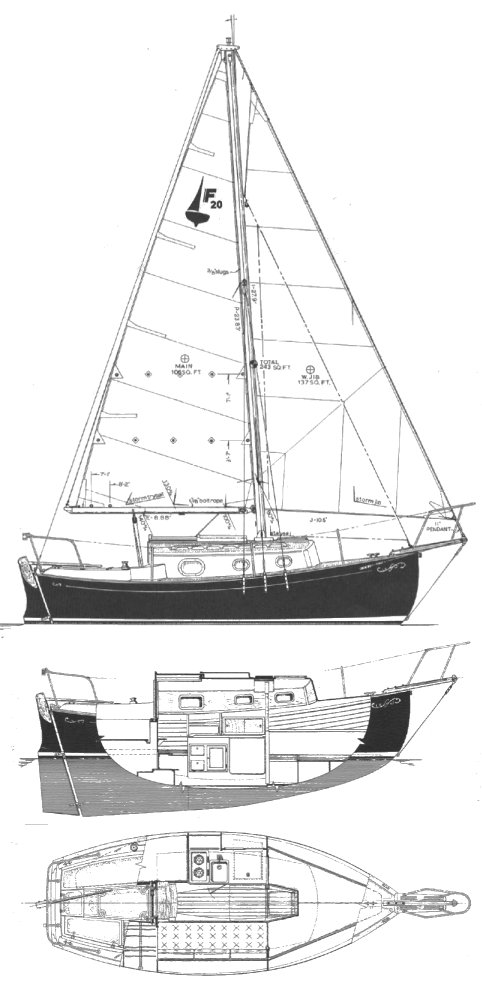
LOA: 24’ LOD: 20’ LWL: 18’2” Beam: 8’ draft: 3’3” Displacement: about 6,000 lbs. Ballast: 1,800 lbs. internal lead. Sail Area: 250 sq ft.
General Comments: In 1972 Bruce Bingham designed the Flicka to be one of the smallest offshore capable pocket cruisers. Built first by Nor-star with some available as owner-finished kits. Pacific Seacraft then built 434 Flickas from 1978 to around 1994. Pluses: Pacific Seacraft sailboats are known for quality construction and good resale value. Some Flickas came powered with an outboard motor. 5’11” headroom. Minuses: This egg-shaped boat is cramped on deck and although relatively spacious below, would be challenging for two liveaboards and the inboard diesel option leaves even less space for gear and provisions. In anything other than ideal conditions the Flicka is slow, particularly in light winds, which is to be expected from putting so much beam, freeboard and displacement into such a small length boat. The lack of a bridge deck on pre-1984 models could expose the cabin to flooding from the cockpit. More info:
Falmouth Cutter 22
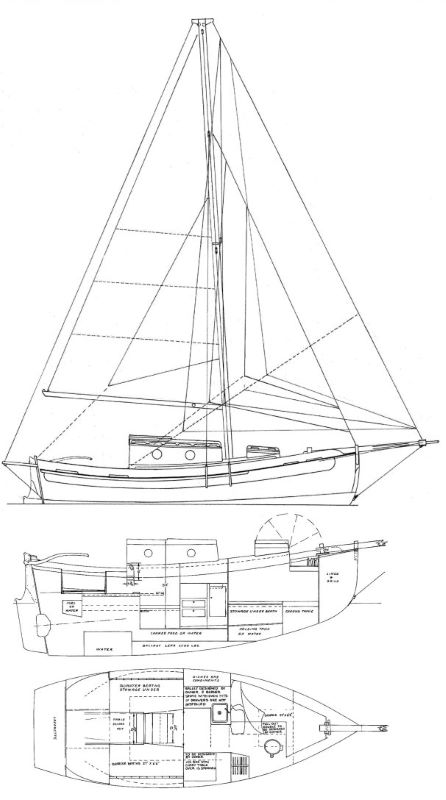
LOD: 30’6” LOD: 22’ LWL: 20’10” Beam: 8’ Draft: 3’6” Displacement: 7,400 lbs. Ballast: 2,500 lbs encapsulated lead.
General Comments: Approximately 39 of these salty Lyle Hess design pocket cruisers were built in fiberglass at Sam L. Morse yard in California and at other yards, including Cape George Marine. Pluses: Her long bowsprit and generous 403 sq. ft. sail area make her performance better than expected for a small and heavy traditional design pocket cruiser. 5’11” headroom under short cabin trunk. Minuses: Rare, expensive and heavy. The interior of such a small boat is obviously cramped for cruising and the standard inboard diesel engine makes it more so, but a small outboard motor is an option and their lesser resale value can make the boat more affordable. Unfortunately, few come on the market. More info:
Bristol 24

LOA: 24’7” LWL: 18’1” Beam: 8’ Draft: 3’5” Displacement: 5,920 lbs. Ballast: 1,900 lbs. internal lead. Sail Area: 296 sq. ft.
General Comments: 726 boats built between 1969-83. Outboard motor well or inboard diesel option. Similar in some dimensions to the Cape Dory 25D. Earlier models called the Sailstar 24 are reported to have concrete/iron ballast and shallow bilge. If the bilge is only about 6″ deep, its’ the Sailstar. Pluses: 6’ cabin headroom. Some later models have a slot in the transom for a tilt-up outboard well, which is a big advantage over a fixed well. More info:
https://sailingmagazine.net/article-1179-bristol-24.html
Pacific Seacraft Dana 24
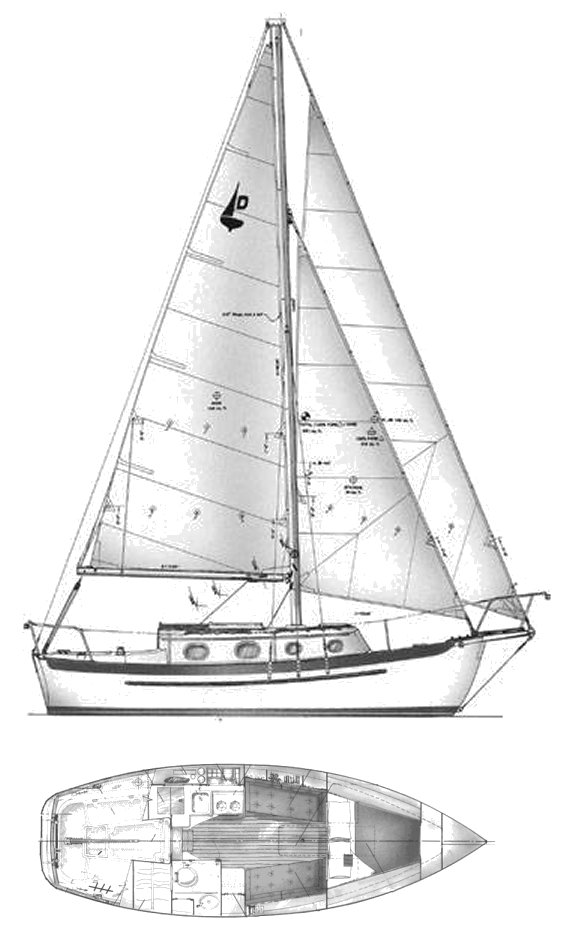
LOA: 27’3” LOD: 24’ LWL: 21’5” Beam: 8’7” Draft: 3’10” Displacement: 8,000 lbs. Ballast: 3,200 lbs. internal lead. Sail area: 358 sq. ft. (100% foretriangle)
General Comments: Bill Crealock design built from 1984-99. 18HP Yanmar diesel standard. Sloop or cutter rig with 3′ long bowsprit. Pluses: 8’7” beam and 6’1″ headroom on a 24 foot boat with open V-berth design makes it surprisingly roomy inside. Eight bronze opening ports. Enclosed head and shower! Minuses: A very expensive 24-footer. More info:
Dana 24 Video Tour https://www.youtube.com/watch?v=ubcqjUby8Yw
http://www.janice142.com/BoatInfo/Dana24…
Bayfield 25
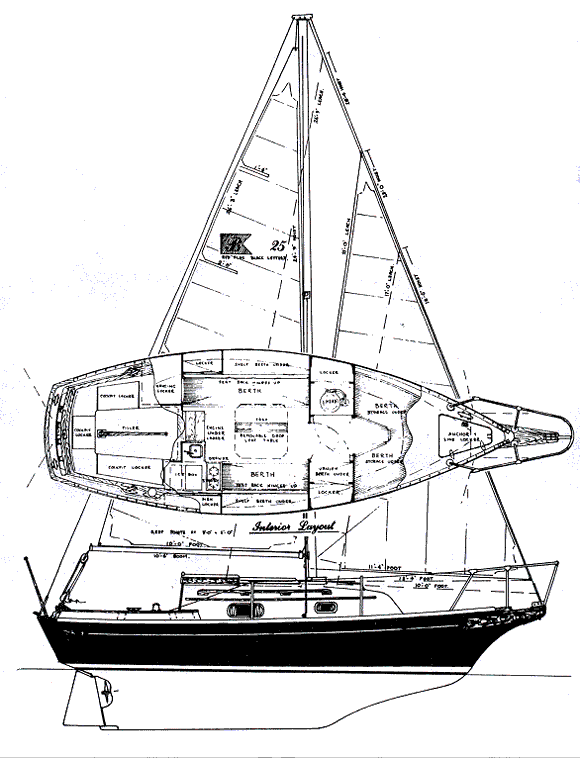
LOD: 25’ LWL: 19’8″ Beam: 8′ Displacement: 4,300 lbs Draft: 2’11” Ballast: 1,500 lbs. Sail area: 240 Sq. Ft.
General Comments: Pluses: Long, full keel makes for shallow draft. Roomy for its size which is closer to 24′ on deck not counting the molded in bowsprit. 6′ headroom. Minuses: Relatively slow in light airs. Its shallow draft keel would seem to indicate less resistance to capsize in storm conditions compared to most other boats on this list. Not a great choice for long or high latitude passages where extreme weather may be encountered but probably suitable for most cruising if passage planning is done carefully. Companionway sill is dangerously low, but could be raised without much trouble. More info:
http://sailquest.com/market/models/bayf25.htm
Cape Dory 25
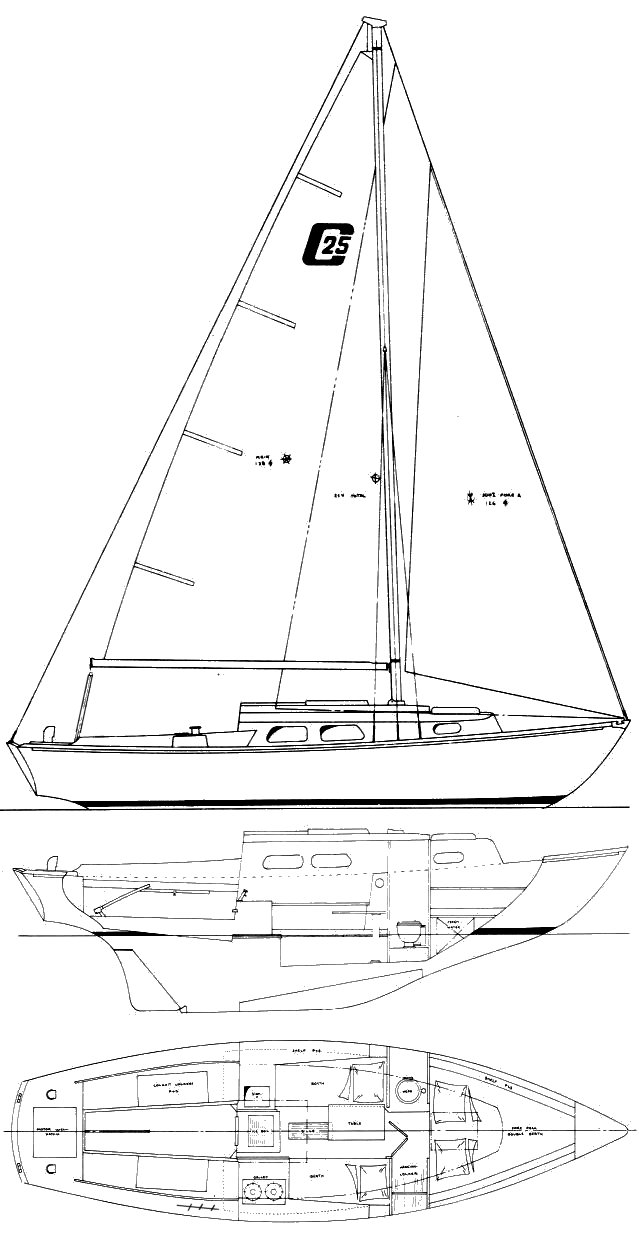
LOD: 24’10” LWL: 18’ Beam: 7’3” Draft: 3’ Displacement: 4,000 lbs. Ballast: 1,700 lbs. Sail area: 264 sq. ft.
General Comments: George Stadel design. 846 boats built between 1972-82. A similar version was built earlier by Allied Boat Company as the Greenwich 24. The 25D version listed below is a different design with diesel inboard. The 25 has an outboard well in lazarette. Minuses: Requires several modifications for offshore safety such as reducing cockpit footwell volume and modifying companionway dropboards so they don’t fall out when raised slightly. Headroom is limited to about 5’. Boats from before around 1979 had fixed ports, later models had bronze opening ports. More info:
http://www.capedory.org/specs/cd25.htm
Cape Dory 25D
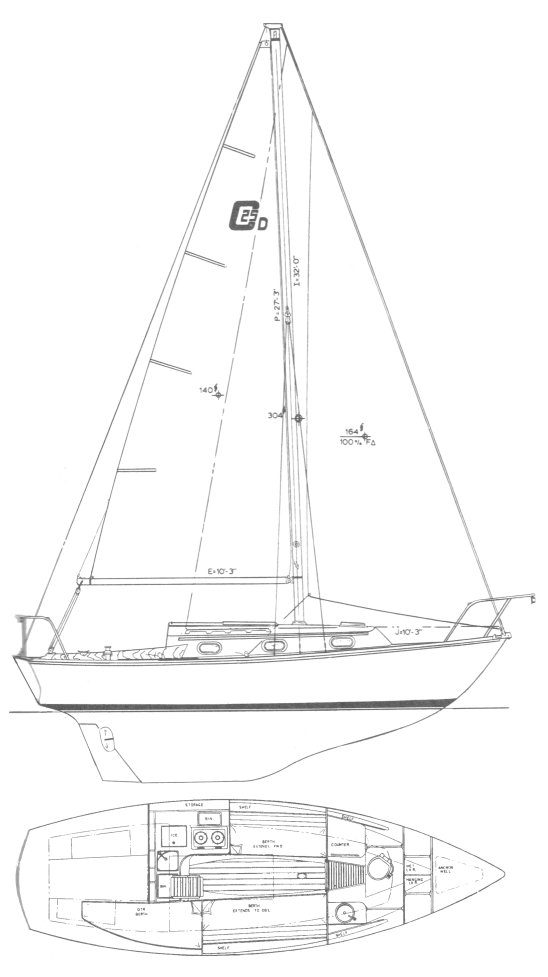
LOD: 25’ LWL: 19’ Beam: 8’ Draft: 3’6” Displacement: 5,120 lbs. Ballast: 2,050 lbs. encapsulated lead.
General Comments: Alberg design. 184 built between 1981-85. Main salon has 5’11” headroom. Large head and shower in place of V-berth.
More info:
http://www.capedory.org/specs/cd25d.htm
Pacific Seacraft 25
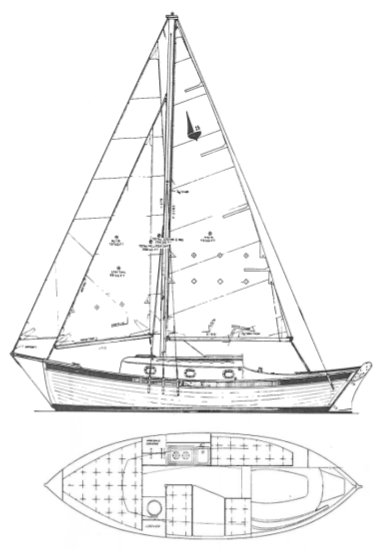
LOA: 26’3” LWL: 21’ Beam: 8’ Draft: 3’3” Displacement: 4,750 lbs. Ballast: 1,750 lbs. encapsulated lead. Sail area: 250 sq. ft. masthead sloop or cutter with bowsprit.
General Comments: Henry Mohrschladt designed double-ended cutter built in the mid to late 1970’s. Pluses: Six opening bronze portlights. Mast can be raised and lowered in its tabernacle. Minuses: Headroom is limited to about 5 feet. Low companionway entrance requires the lower dropboards be secured at sea. The 8 HP inboard Yanmar is hard to access unless you remove the cockpit footwell floor which is difficult to seal. Although small double-ender designs such as this are a good candidate for going engineless with a sculling oar or pair of sweeps or an electric inboard if you don’t require more than a couple hours motoring between charges of the battery bank, the only other option is to keep the inboard diesel.
More info: Reviewed in John Vigor’s Twenty Small Sailboats to Take You Anywhere.
Rhodes Meridian 25
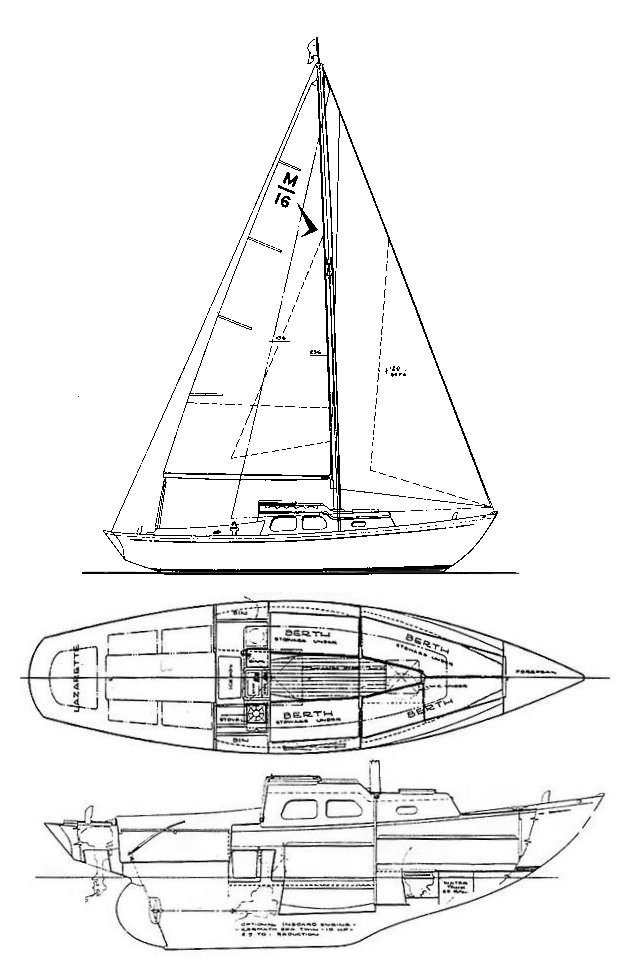
LOA: 24’9” LWL: 17’6” Beam: 7’ to 7’3” Draft: 3’3” to 3’7” Displacement: 5,300 lbs. Ballast: 2,300 lbs.
General Comments: Built in Holland in the 1960’s. Several versions available, including the Seafarer with more beam and draft in later models. Some came with an outboard well. Pluses: Beautiful sheer line and practical interior layout with 5’8” headroom in salon. Minuses: Not many of these boats are available on the market. Many came with wooden spars prone to rot over the years. Avoid the few late 1960’s models that had fin keel with detached rudder.
More info:
https://sailboat.guide/seafarer/meridian-25
Vancouver 25

LOD: 25′ LWL: 21’8″ Beam: 8’6″ Draft: 3’10” Displacement: 7,380 lbs. Ballast: 3,000 lbs.
General Comments: Designed by Robert Harris who also designed the Vancouver 27/28. Up to about 40 of these pocket cruisers were built mostly in Taiwan around the early 1980’s. A few may have been built in Thailand and California. Full keel with slightly cutaway forefoot and short bowsprit. Pluses: Nicely fitted out with teak and bronze hardware. Standing headroom reported to be at least 6′. Minuses: An inboard engine may not be what some people want on a boat of this size, but is mostly unavoidable on a double-ender design.
More info:
https://veronaleslie.wordpress.com/category/vancouver-25s/
Contessa 26 / Taylor 26
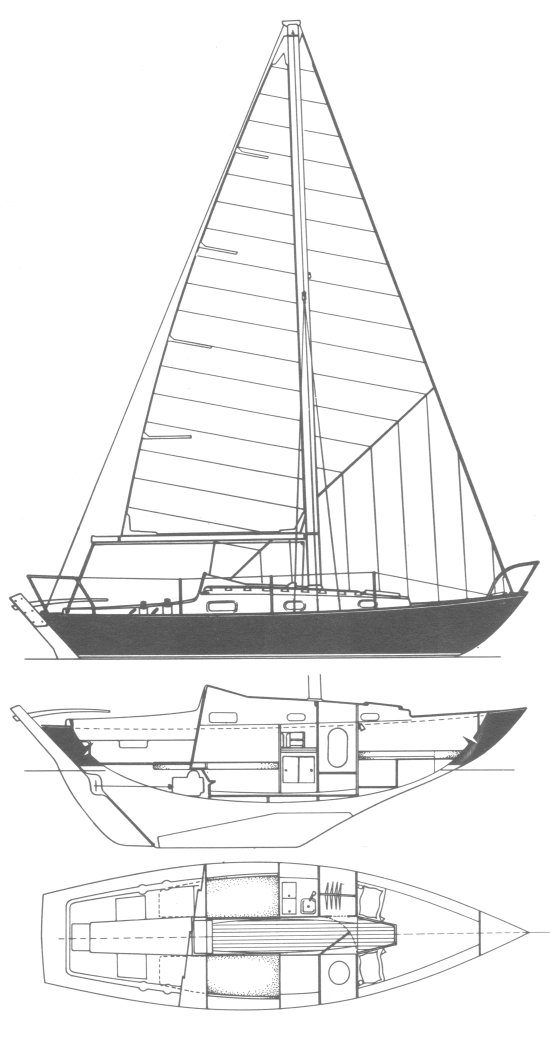
LOD: 25’6” LWL: 21’ Beam: 7’6” Draft: 4’ Displacement: 5,400 lbs. Ballast:
General Comments: Designed by David Sadler based on the International Folkboat. Several hundred were built in Canada as the Taylor 26 and in the UK as Contessa 26. After 1983 the Taylor 26 began using lead ballast instead of iron, lowered the cabin sole for more headroom and stability, amidships hatch added for light and ventilation, newer model Yanmar diesel and other improvements. Pluses: Proven circumnavigator. The 1983-90 production boats appear the best choice. Minuses: Instead of the traditional sliding companionway hatch, the boats have a raised bubble to the coachroof, which causes the boat to feel cramped, reduces ventilation and makes it awkward to take quick checks of the horizon when on watch in foul weather. As I was prepping a Contessa for an offshore delivery from Brunswick, GA to Maine I noticed the side decks are so narrow it’s a tight squeeze to get by between the dodger and lifelines. Also the dodger obstructs the jib sheet winches. Because the salon bunks are moved aft as quarterberths, the galley is located forward of the bunks, forcing you to cook on your knees and making the boat hot. The advantages of the massive outboard hung rudder are offset by the inability to replace the inboard diesel with an outboard well. But an outboard bracket on a corner of the transom is a possibility.
More info:
Contessa Corner website and forum
Cape Dory 26
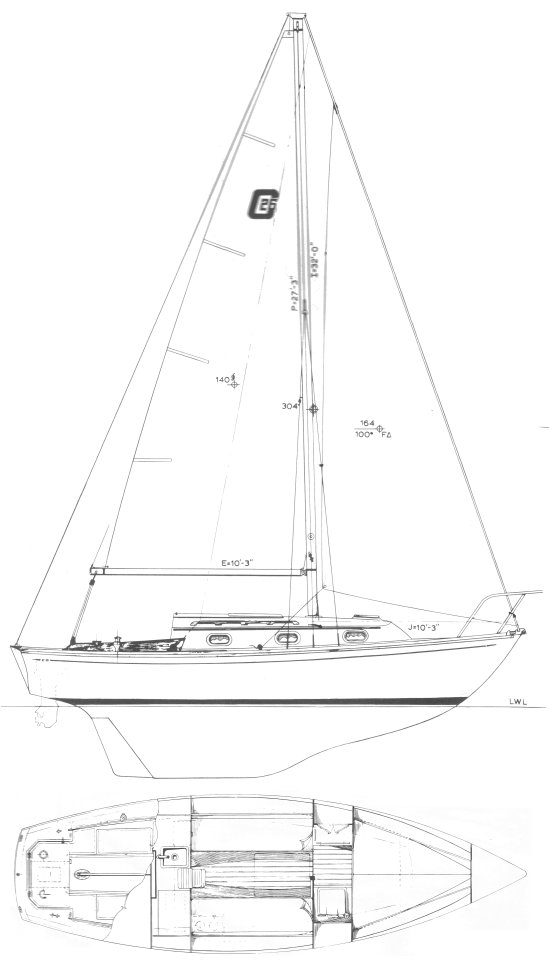
LOD: 25’11” LWL: 19’3” Beam: 8’ Draft: 3’7” Displacement: 5,300 lbs. Ballast: 2,400 lbs. Sail area: 304 sq. ft.
General Comments: Alberg design. 78 were built between 1984-88. Most have an outboard motor well in lazarette. Pluses: 5’11” headroom. More info:
http://www.capedory.org/specs/cd26.htm
Cheoy Lee Offshore 26
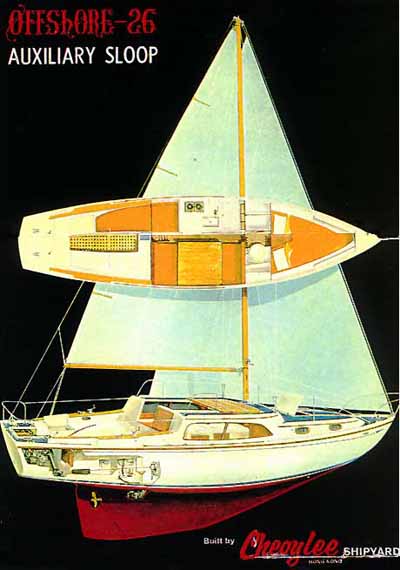
LOD: 25’7” LWL: 20’11” Beam: 8’10” Draft: 3’9” Displacement: 6,100 lbs. Ballast: 2,240 lbs.
More info:
http://www.cheoyleeassociation.com/offshore26.htm
Columbia 26 (classic model)
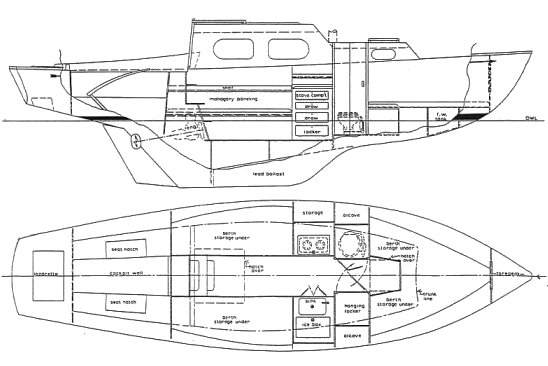
LOD: 26’4″ LWL: 19′ Beam: 8′ Draft: 4′ Displacement: 5,200 lbs. Ballast: 2,300 lbs. lead. Sail area: 321 sq.ft.
General comments: Some 700 boats built between 1963-69. Outboard well. Pluses: 6’1″ headroom for those who need it. Not to be confused with the fin keel/spade rudder MKII and later versions. More info:
http://www.columbia-yachts.com/c-26.html
International (IF) or Nordic Folkboat 26
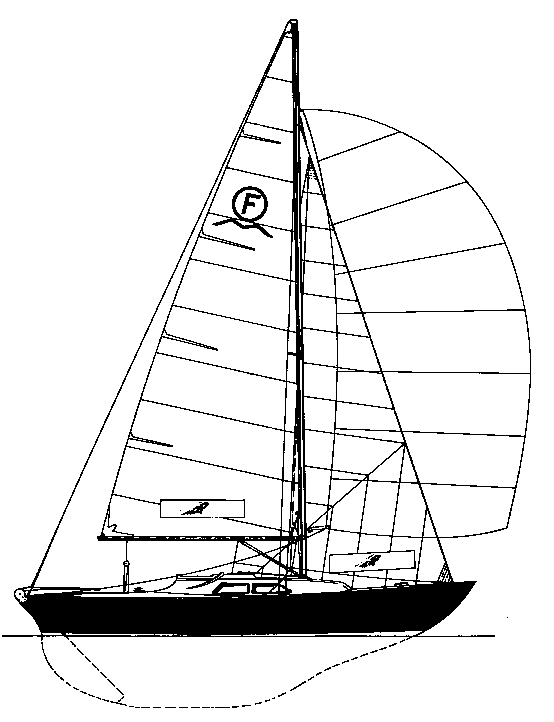
LOD: 25’1” LWL: 19’8” Beam: 7’5” Draft: 3’11” Displacement: approx. 5,000 lbs. Ballast: 2,750 lbs. iron. Sail area: 258 sq. ft.
General Comments: Updated Tord Sunden designed fiberglass version of the original 25’ wooden folkboat. Built by various manufacturers of similar design mostly from Sweden and Denmark between 1967-84. Different models varied in areas such as cockpit design, inboard engine or outboard options, aluminum masthead or wooden fractional rig. Pluses: More than half it’s displacement is ballast which makes this small, low freeboard boat very stable for it’s size. Over three thousand have been built with many still on the market in Europe and over one hundred in the USA. Our English friend, Tony Curphey, completed a circumnavigation in his folkboat in the 1990’s. Minuses: Although capable of offshore voyages they were mainly designed for racing or short cruises and are cramped below with max headroom of 4’8″. A wet ride going to windward.
More info: Some of the site below is in English, including a review in Good Old Boat Magazine under the Articles link. Also reviewed in John Vigor’s book, Twenty Small Sailboats to Take You Anywhere.
http://www.ifboat.com/indexe.htm
Kaiser 26
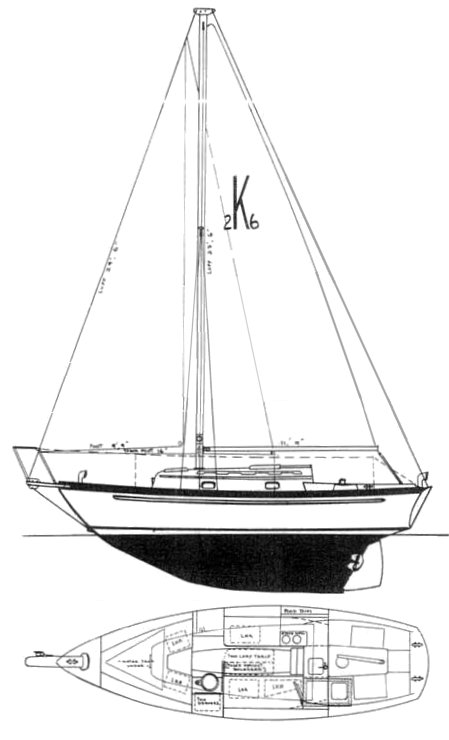
LOA: 27’6” LOD: 26’ LWL: Beam: 7’10” Draft: 4’ Displacement: 6,200 lbs. Ballast: 2,700 lbs.
General Comments: Only 26 of these were built by John Kaiser, Sr. of Wilmington, Del. Pluses: At least 5’10” headroom. Minuses: Hard to find on the market.
More info: Little info online, but here are some owner’s comments.
http://www.sailnet.com/forums/…
Morris Frances 26
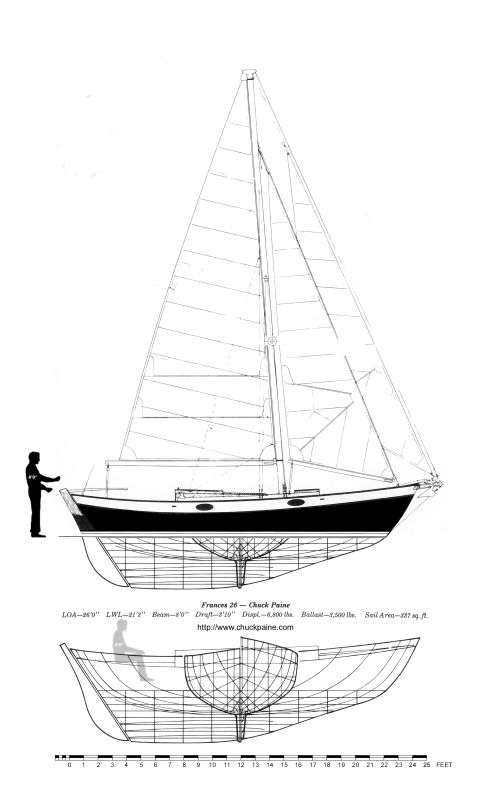
LOD: 26’ LWL: 21’3” Beam: 8’ to 8’2” Draft: 3’10” Displacement: 6,800 lbs. Ballast: 3,500 lbs. (external or encapsulated lead)
General Comments: Double-ended cutter or 7/8 sloop designed by Chuck Paine. About 42 built by Morris Yachts, also called the Morris 26. Others were built by Victoria Marine in Britain and called the Victoria 26. Flush-decked or 6’ headroom in cabin trunk version. Pluses: High quality construction, beautiful design, good high ballast ratio. A singlehanded voyager’s dream. Minuses: Expensive. Keel-stepped mast is strong but cannot be raised or lowered without a crane, which is a disadvantage if you intend to trailer her often. Inboard engine, even a small Yanmar 1GM10, takes up much useable space and an outboard motor is difficult to fit and unsightly on a double-ender.
More info:
http://frances26.org/reviews.html
http://www.janice142.com/BoatInfo/Frances26/
Pearson Ariel 26
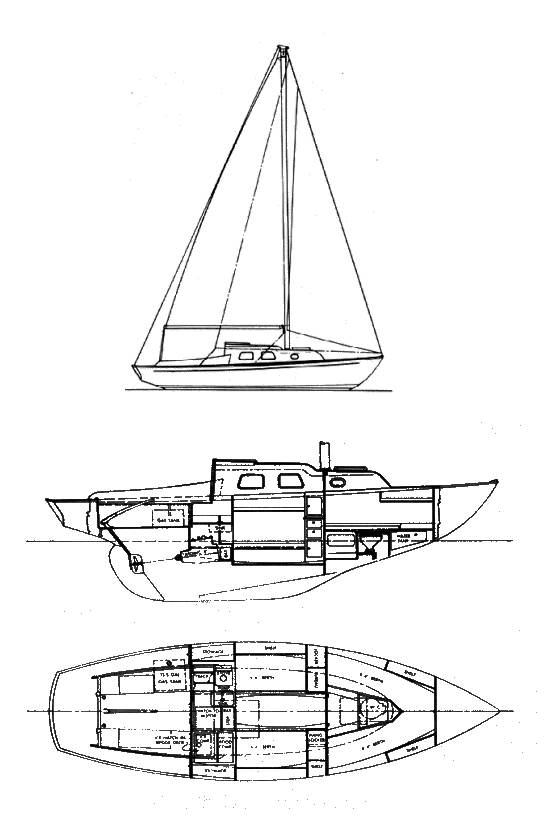
LOD: 25’7” LWL: 18’8” Beam: 8’ Draft: 3’8” Displacement: 5,120 lbs. Ballast: 2,300 lbs. lead.
General Comments: Another classic Alberg design. The Pearson Commander 26 is the same hull design as the Ariel, but much shorter cabin and longer cockpit make the Commander better suited to daysailing. Atomic 4 inboard or outboard motor well in lazarette. Plusses: Active owners association. Minuses: Like most of the factory installed motor wells out there, the motor does not tilt up for sailing so it either gets dragged through the water under sail of must be awkwardly lifted out and stored in another locker. I haven’t measured it but there may not be adequate space between the transom and rudder shaft to make a tilt-up conversion. Check my outboard well article in this site for more info.
More info:
http://pearsonariel.org/
Voyager 26
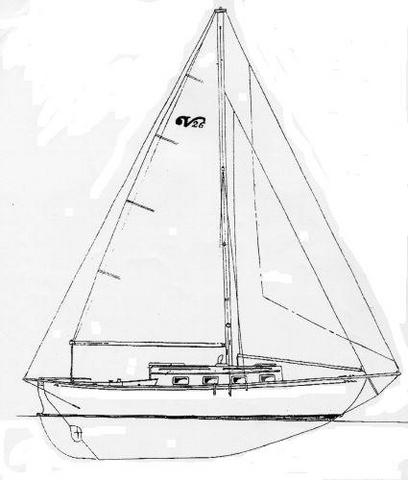

LOA: 30’5″ LOD: 26′ LWL: 21’3″ Beam: 8’3” Draft: 3’4″ Displacement: 6,600 lbs. Ballast: 2,650 lbs. lead.
General Comments: Daniel Avourer designed double ended cutter built by Voyager in 1980’s. Diesel inboard standard. Pluses: Full keel with shoal draft. Good quality build and attractive lines. Six or eight bronze opening ports. Minuses: Relatively rare.
More info:
http://www.sailboatdata.com/viewrecord.asp?class_ID=4664
Westerly Centaur 26
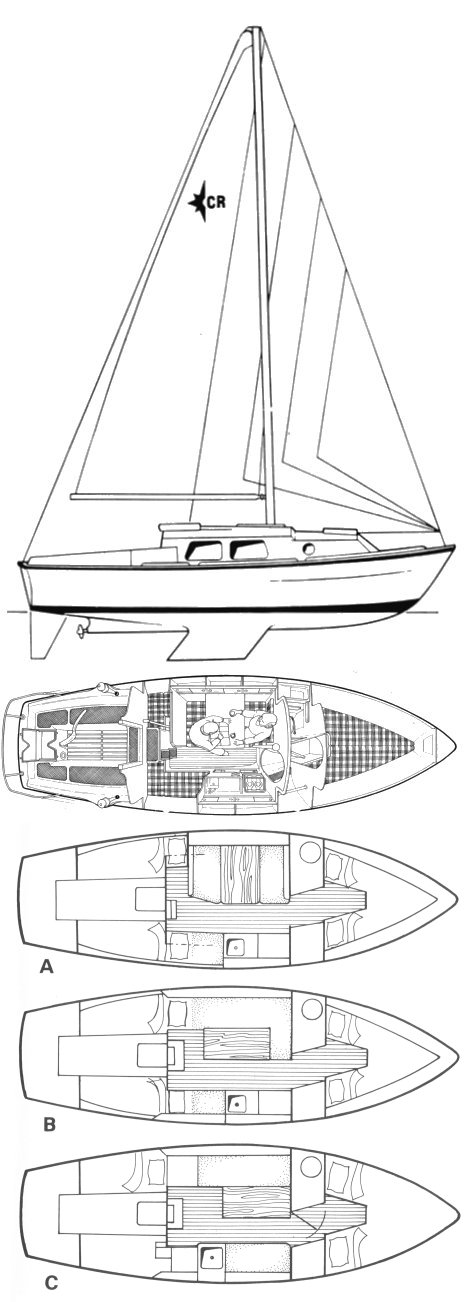
LOD: 26’ LWL: 21’4” Beam: 8’5” Draft: 3’ Displacement: 5,500 lbs. Ballast: cast iron. Sail area: 294 sq. ft. (100% foretriangle)
General Comments: This UK built boat’s shallow draft and ability to stand upright on her twin keels may be a priority for some sailors which is why I made an exception to this list’s modified full keel requirement and included it here. Some 2,500 were built from 1969-80. A friend of ours completed a solo circumnavigation in an outboard motor powered WC26 in 1997 without serious problems. Pluses: Great 3’ draft twin-keel concept if you want to stand the boat upright in shallow tidal harbors. The boat has more than expected stowage area. Minuses: If only the builder could put twin keels on a more attractive design. The twin keels are notably less efficient than a single deep fin keel, and perhaps even less than the windward performance of a similar full-keeled boat. In any case, this boat is relatively slow. Most were fitted with inboard engines.
More info:
https://www.spinsheet.com/boat-reviews/westerly-centaur-26-used-boat-review
6Albin Vega 27

LOD: 27’1” LWL: 23’2” Beam: 8’1” Draft: 3’10” Displacement: 5,070 lbs. Ballast: 2,020 lbs.
General Comments: Over 3,400 of these boats were built in Sweden between the mid 1960’s to 1979. 5’10” headroom in salon and galley. Pluses: Her proportions are well designed even if her overall appearance is unremarkable. Numerous long offshore passages have been documented including a circumnavigation of the Americas. Minuses: Some of these boats lack opening ports, reducing ventilation. Deck-stepped mast beam may need reinforcing. Chain plates are mere 8mm U-bolts bolted through the deck to hull flange in the European style and although most boats have not had problems with them, some have so you might consider adding external chain plates. Parts of the bilge are impossible to access due to the inboard engine and tanks.
More info at:
http://www.bluemoment.com/boatreviews/vegareview.html
http://www.albinvega.com/vegadescription.html
Bristol 27
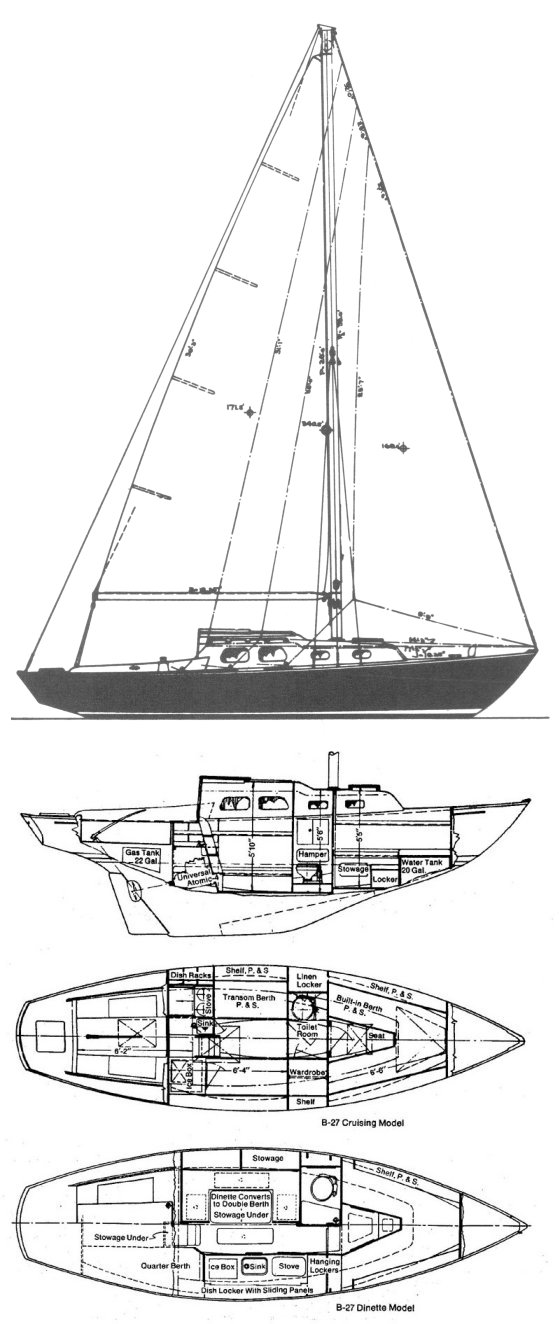
LOD: 27’2” LWL: 19’9” Beam: 8’ Draft: 4’ Displacement: 6,600 lbs. Ballast: 2,575 lbs. internal lead. Sail area: 340 sq. ft.
General Comments: Alberg design that closely resembles the slightly larger Pearson Triton. About 337 built by Clint Pearson from 1966-78. Outboard motor well in lazarette standard. Optional Atomic 4 inboard. Some differences between cruising model, dinette model and the weekender that has shortened cabin and too large a cockpit for offshore. The drawing indicates 5’10 headroom in main cabin and either 5’8″ or possibly 5’6″ in head. Pluses: The dimensions of the overhanging transom looks like it would be suitable to convert from a fixed outboard well to a more functional tilt-up 6 hp version. Minuses: Some owners claim the boat is tender and is improved by adding up to 300 lb. ballast aft of the water tank. Although generally well constructed, the boats are aging and the bolted hull to deck joint is prone to leaks.
More info:
https://www.practical-sailor.com/sailboat-reviews/bristol-27
Cape Dory 27

LOD: 27’1” LWL: 20’ Beam: 8’6” Draft: 4’ Displacement: 7,500 lbs. Ballast: 3,000 lbs. Sail area: 365 sq. ft.
General Comments: Alberg design. 227 built between 1976-84. 5’10” headroom. Diesel engine standard but with 30 inches between transom and rudder post it could be converted to an outboard well to simplify if desired. Minuses: Recessed deck anchor locker on some boats does not allow storage space for long rode or anchor windlass but it can be converted to a standard chain locker below deck similar to what I described in my Columbia 8.7 refit article.
More info:
http://www.capedory.org/specs/cd27.htm
Cheoy Lee Newell Cadet / Offshore 27

LOD: 26’10” LWL: 19’6” Beam: 7’8” Draft: 4’4” Displacement: 6,900 lbs. Ballast: 2,700 lbs. (iron in cement) General Comments: At least two versions were built in the 1960’s at the Honk Kong yard. Minuses: Teak decks from the 1960’s are a maintenance problem. More info:
http://www.cheoyleeassociation.com/N_CadetMain.html
Dockrell 27
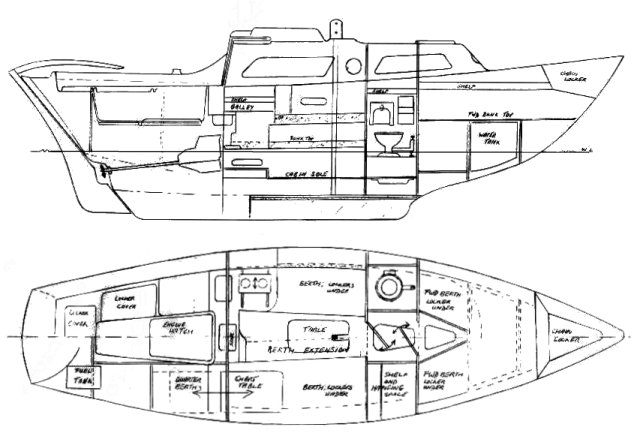
LOD: 27’ LWL: 21’ Beam: 8’ Draft: 3’ Displacement: 7,000 lbs. Ballast: 3,200 lbs. long iron wing keel. General Comments: British built long-keeler with shallow draft, cutter rigged with a self-tacking boomed staysail and the mast in a tabernacle. Pluses: Shoal draft and possible to stand upright on her wing keel in protected harbors or with legs added to stabilize her. Proven passage maker. Minuses: Somewhat slow to windward.
More info:
http://www.yachtsnet.co.uk/archives/dockrell-27/dockrell-27.htm
Halcyon 27
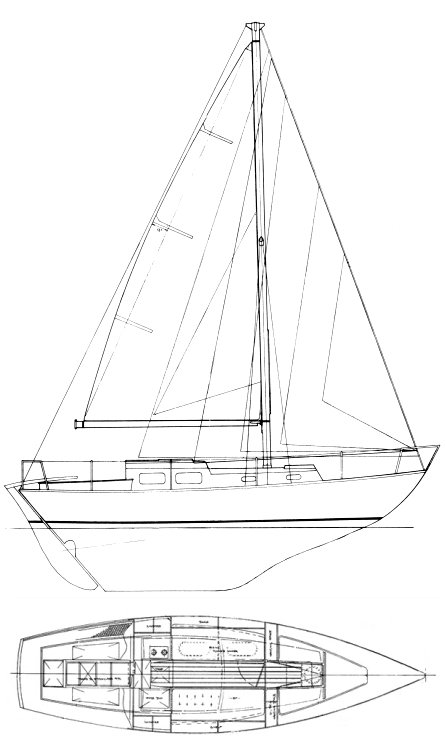
LOD: 27’ LWL: 20’3″ Beam: 7’8″ Draft: 4’ Displacement: 6,720 lbs. Ballast: 3,000 lbs. encapsulated lead. Sail area: 365 sq. ft. main and genoa. General Comments: Designed by Alan Buchanan in 1968. Some 200 were built in UK by Offshore Yachts. Full keel with slightly cutaway forefoot with transom hung rudder. Pluses: Solid passage maker with attractive lines. For those who need the extra height she has about 6′ headroom under the doghouse which is better than most folkboat derivatives such as the Contessa 26. Minuses: Few available outside UK.
More info:
http://www.yachtsnet.co.uk/archives/halcyon-27/halcyon-27.htm
Pacific Seacraft Orion 27
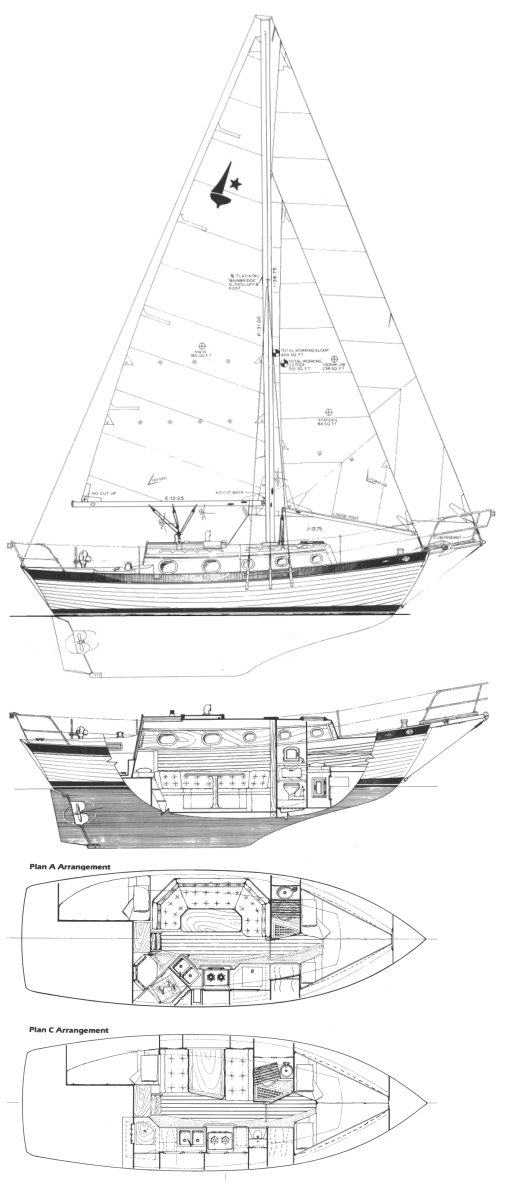
LOA: 30’ LOD: 27’ LWL: 22’2” Beam: 9’3” Draft: 4’ Displacement: 10,000 lbs. Ballast: 3,800 lbs. Sail area: 445 sq. ft. ?
General Comments: Henry Morschladt designed Cutter rig with bowsprit. 6’1” headroom. Pluses: The Mark II version has longer coachroof, extra ports and hatch. Minuses: Most boats on the market seem to have the wheel steering option, but could be converted back to tiller. Many have an “A” layout plan with a U-shaped dinette opposite a long galley which means there is no bunk in the center salon, but the table does convert to a double bunk and there is a pilot berth. More info: https://sailingmagazine.net/article-2125-pacific-seacraft-orion-27.html
Nor’Sea 27

LOA: 31’ LOD: 27’ LWL: 25’ Beam: 8’ Draft: 3’10” Displacement: 8,100 lbs. Ballast: 3,100 lbs.
General Comments: Lyle Hess design built by various yards over the years. One of the larger “trailerable” offshore cruisers. Rig height varied by 4-foot for heavy and light air versions. Minuses: Most were built with what some consider an awkward aft cabin layout. Some boats were owner finished and early models had perhaps less than optimal ballast.
More info:
https://www.spinsheet.com/boat-reviews/norsea-27-used-boat-review
Rossiter Pintail 27

LOA: 27′ LOD: 23’ LWL: ” Beam: 8’9” Draft: 3’7″ Displacement: 11,600 lbs. Ballast: 4,600 lbs. Sail area: sq. ft.
General Comments: Built originally in wood then in fiberglass during the early 1970s by Rossiter Yachts in England. Full keel encapsulated lead ballast and integral molded bilge keels to allow her to have shallow draft and stand upright when drying out at low tide. Headroom 5’9″. Sloop rig. Came with Lister 15hp diesel.
More info:
https://sailboatdata.com/sailboat/pintail-rossiter
Sea Sprite 27/28

LOD: 27’11” LWL: 20’ Beam: 8’10” Draft: 4’3” Displacement: 7,600 lbs. Ballast: 3,600 lbs. General Comments: Bill Luders design built by C. E. Ryder. 6’ headroom.
More info:
http://www.pickedwiss.com/sea_sprite_28/
http://www.seaspriteassociation.com/
Tartan 27
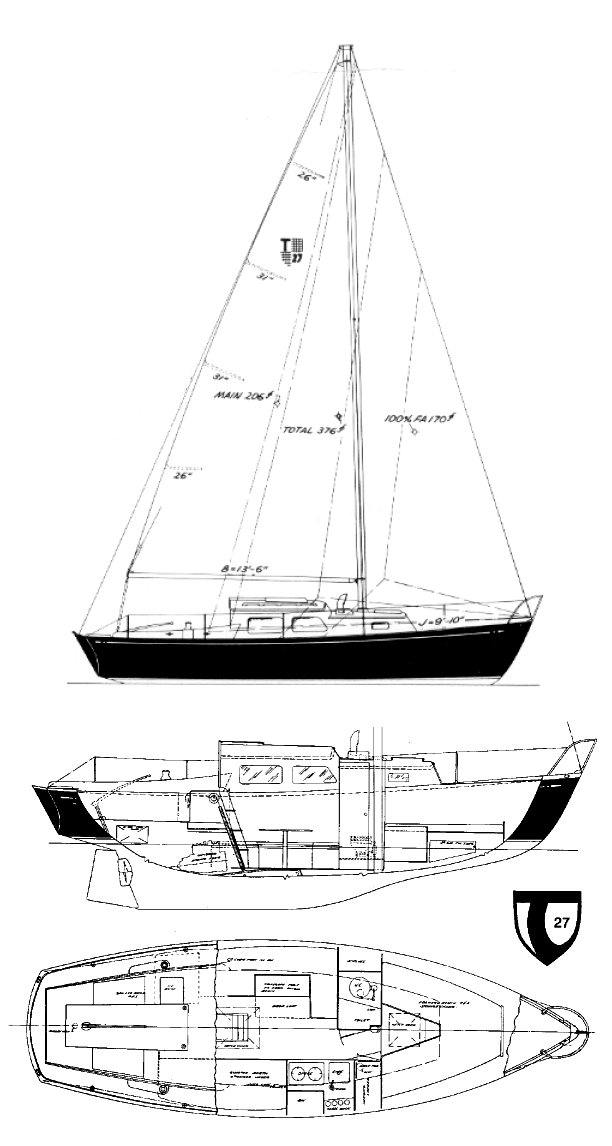
LOD: 27’ LWL: 21’4” Beam: 8’8” Draft: 3’2” with board up, 6’4” board down. Displacement: 7,400 lbs. Ballast: 2,400 lbs.
General Comments: About 700 of these S&S design keel/centerboard cruisers were built between 1961-79. The boats built before the 1976 raised sheer redesign had a classic stepped deckhouse and were more cramped inside, but are preferred by some for their aesthetics and more accessible deck layout. Pluses: Shoal draft of 3’2”. Headroom of nearly 6′. Minuses: Shoal draft keel/centerboard designs are potentially less likely to recover from a knock-down beyond 90 degrees in extreme conditions, but her ample long keel minimizes this threat.
More info:
Tartan Owners Group
Vancouver 27/28

LOD: 27’ LWL: 22’11” Beam: 8’8” Draft: 4’3” Displacement: 8,800 – 8,960 lbs. Ballast: 3,500 lbs.
General Comments: Designed by Robert Harris as a sturdy ocean passage maker. Cutter rigged with outboard rudder. Built first from 1973-88 in British Columbia on semi-production basis. Later built in Britain by Pheon Yachts who reportedly added a few inches of tumblehome to make her a bit stiffer. Then built by Northshore Yachts who added a foot to the length of the cockpit to make the Vancouver 28. Two versions were built: one with quarterberth and head forward and the other with a V-berth and no quarterberth. Pluses: Headroom is about 6’1″. Large water and fuel tanks. Minuses: Somewhat high-sided and a heavy boat not known for great light air performance. Canadian version reported prone to blistering and some were owner finished with varying quality.
More info: https://www.boats.com/reviews/pocket-voyager/
Bristol Channel Cutter 28

LOA: 37’9” LOD: 28’1” LWL: 26’3” Beam: 10’1” Draft: 4’10” Displacement: 14,000 lbs. Ballast: 4,600 lbs.
General Comments: Lyle Hess design built in fiberglass at Sam L. Morse yard in California. Some were built under license at other yards. Currently built at Cape George Marine. Pluses: Classic exquisite design and high quality construction. Minuses: Rare on the market, expensive and heavy.
More info:
http://capegeorgecutters.com/_boat-designs/bristol-channel-cutter-28/
Cape Dory 28
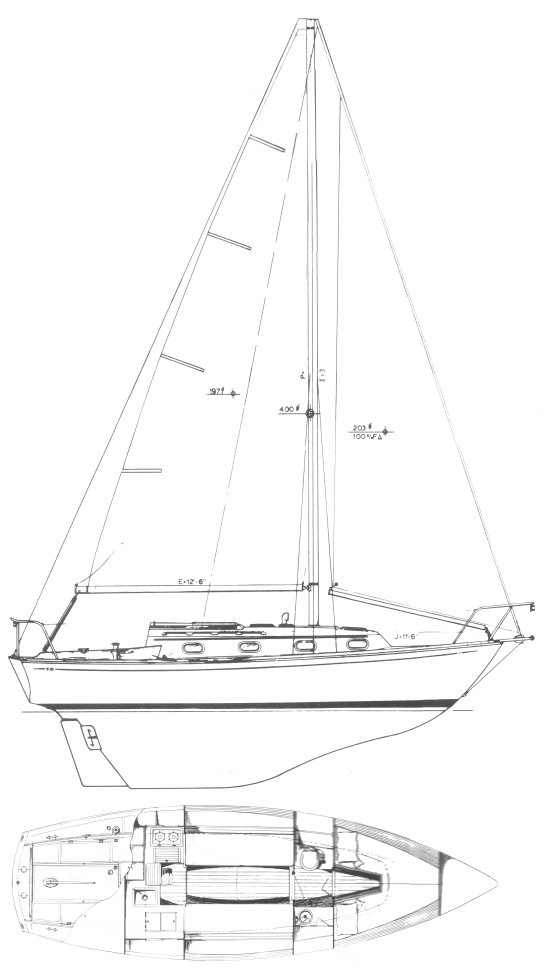
LOD: 28’1” LWL: 22’2” Beam: 8’10” Draft: 4’ Displacement: 9,000 lbs. Ballast: 3,500 lbs. Sail area: 404 sq. ft.
General Comments: Alberg design. About 389 built between 1975-84. Most were powered by two-cylinder 15-hp Volvo diesels that may be reaching the end of their lifespan. Pluses: 6’2″ headroom. Minuses: Boats built prior to 1978 had plastic ports instead of bronze and no bridgedeck, with low companionway entrance that is best modified for safer offshore passages.
More info:
http://www.capedory.org/specs/cd28.htm
Cheoy Lee Offshore 28
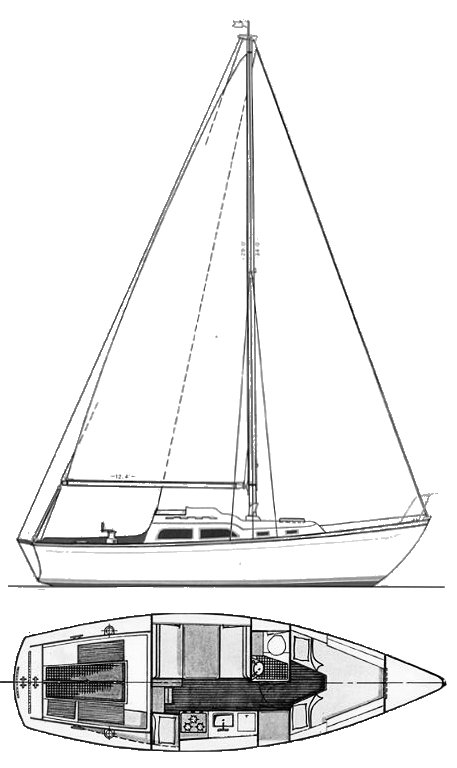
LOA: 28’ LWL: 22’ Beam: 9’2” Draft: 3’6” with centerboard up. Displacement: 8,000 lbs. Ballast: ? modified full keel with centerboard. Sail area: 377 sq. ft.
General Comments: Bill Luders design. Inboard diesel standard. Tiller or wheel options. Pluses: Moderate draft. Minuses: Teak decks of this era require replacing or removal. Like most centerboard keels, they are prone to jam, break cables, and are difficult to maintain. Better to avoid a centerboard unless the design is of proven quality and you need the shallow draft for your cruising area.
More info:
http://www.cheoyleeassociation.com/offshore28.htm
Great Dane 28
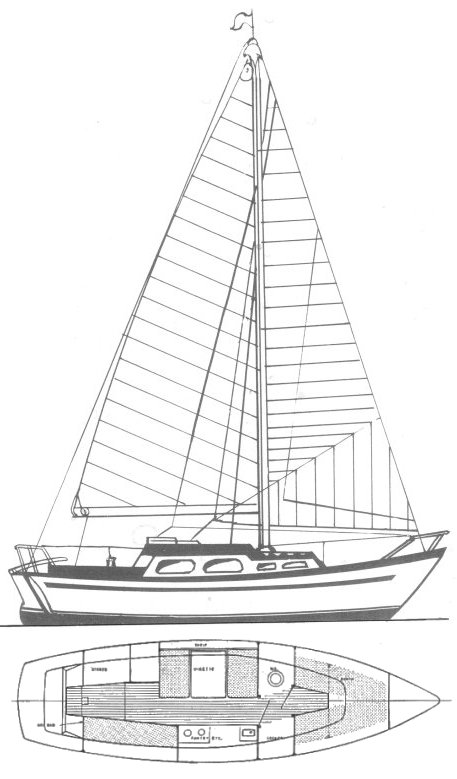
LOA: 28’ LWL: 21’4″ Beam: 8’2″ Draft: 4’6″ Displacement: 8,500 lbs. Ballast: 3,900 lbs. Sail area: 370 sq. ft.
General Comments: Some 250 were built in Denmark between 1964-80. Transom/keel-hung rudder. Pluses: Boasts 6′ headroom despite her sleek low profile.
More info:
http://gd28.wikidot.com/start
L. Francis Herreshoff H-28
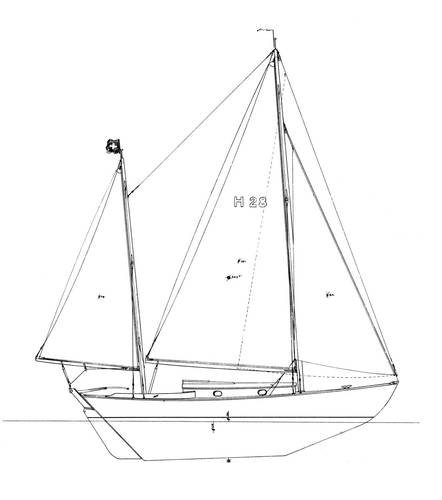
LOA: 29’6” LWL: 23’ Beam: 8’10” Draft: 3’11” Displacement: 7,300 lbs. Ballast: 3,950 lbs.
General Comments: Some were built in wood. Of the fiberglass versions, some 300 were built by Compass Yachts of New Zealand from early 1970’s until 1984. Differences to Herreshoff’s original design are a lifted sheer, longer cabin trunk with raised dog house with lowered keel to compensate for increased headroom, and increased length to 29.5 feet.
More info:
https://sailboatdata.com/sailboat/h-28-herreshoff
Liberty Yachts Custom 28
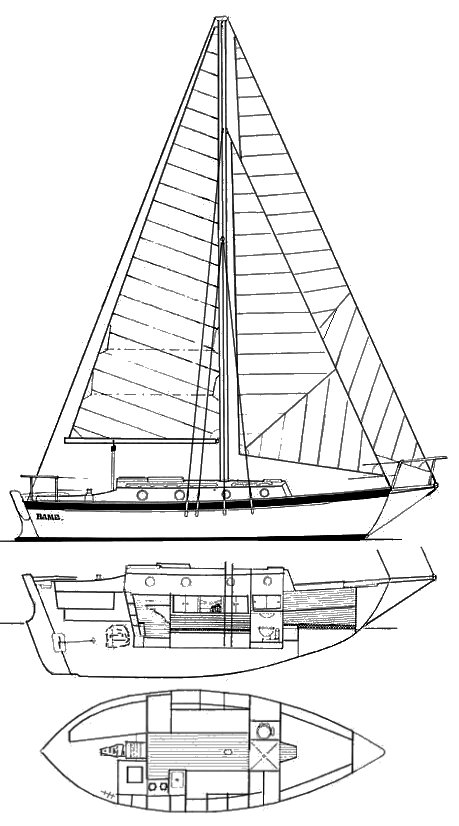
LOD: 28’ LWL: 24’ Beam: 9’6” Draft: 4’ Displacement: 12,000 lbs. Ballast: 5,000 lbs.
General Comments: A very heavily constructed double-ended, full keel cruiser. Cutter rig with bowsprit. Built in the 1980’s. Pluses: 6’2” headroom. Minuses: Expensive and heavy.
More info:
http://www.sailboatdata.com/viewrecord.asp?class_ID=4480
Morris Linda 28

LOA: 28’1” LWL: 23’4” Beam: 9’2” Draft: 4’4” Displacement: 8,300 lbs. Ballast: 3,900 lbs exterior lead.
General Comments: Chuck Paine design built by Morris Yachts. Pluses: Exquisite design details and quality Morris construction. 6’ headroom. Minuses: Expensive.
More info:
https://bluewaterboats.org/morris-28-linda
Pearson Triton 28
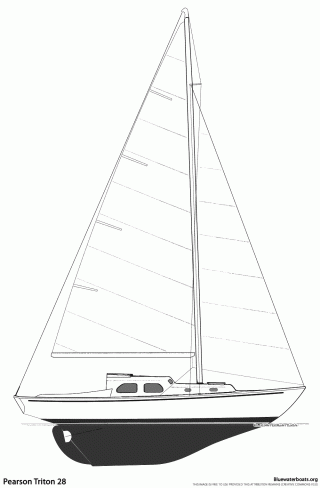

LOD: 28’6” LWL: 20’6” Beam: 8’3” Draft: 4’ (later models 4’3”) Displacement: approx. 8,000 lbs. Ballast: 3,019 lbs. (early models before hull #383 external lead, later models encapsulated lead.) Sail area: 362 sq. ft. 100% foretriangle fractional rig.
General Comments: Designed by Carl Alberg in 1959 with over 700 built until 1967. Some were built on the West Coast with slight design and construction differences. Pluses: Plentiful and affordable on the US East coast. 6′ headroom in salon. Lack of interior fiberglass hull liners make modifications and repairs easier. Her short waterline makes her glide easily through the waters running downwind and in light air and when the wind picks up she heels to pick up waterline length and increase hull speed. Minuses: Original East Coast fractional sloop or yawl rig is lightly stayed and requires heavier chain plates and reinforced mast beam for offshore voyaging. Balsa deck cores (on East Coast built boats) and wood rudders need replacing at some point. Cramped galley. Low freeboard, about 2-foot aft, makes her a wet sail to windward and less roomy below than newer boats, but I prefer a boat with low freeboard because it has less resistance to wind and wave and is handy to get aboard from the water or dinghy. The large and low cockpit makes her susceptible to storm waves filling the cockpit so a secure hatch and lockers is important.
More info:
Alberg Sailboats
Triton Atom Video Tours:
Triton Interior Tour
Triton Exterior Tour
Rhodes Ranger 28/29

LOA: 28’6″ LWL: 20′ Beam: 8′ Draft: 3’10” Displacement: 7,500 lbs. Ballast: reported as 1,900 lbs. external iron or 2,750 lbs. lead.
General Comments: Philip Rhodes design built by Seafarer in Holland in the 1960’s. Don’t confuse with Gary Mull design Ranger 28. Pluses: 5’10” headroom. Some have optional outboard well in lazarette and the others would be suitable to make the conversion yourself. Minuses: Many have wooden spars that require more vigilance and maintenance than aluminum.
More info:
https://sailboatdata.com/sailboat/rhodes-ranger-29
Shannon 28

LOA: Just under 32′ including pulpit and outboard hung rudder. LOD: 28’2” LWL: 22’11”’ Beam: 9’6” Draft: 4’3” Displacement: 9,300 lbs. Ballast: 3,600 lbs. encapsulated lead. Sail area: 470 sq. ft. cutter.
General Comments: About sixty of these high quality Walter Shultz design cutters were built by Shannon Yachts of Bristol, R.I. since 1978. Modified full keel with cutaway forefoot and full skeg-protected rudder. Two-cylinder Yanmar. Pluses: 6′ headroom. Minuses: Expensive.
More info:
https://bluewaterboats.org/shannon
Southern Cross 28
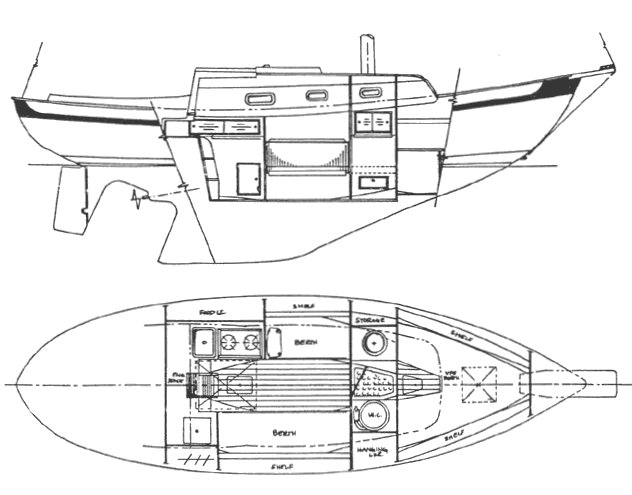
LOA: 30’5” LOD: 28’ LWL: 20’2” Beam: 8’6” Draft: 4’8” Displacement: 8,500 lbs. Ballast: 3,400 lbs.
General Comments: Thomas Gillmer design. Airex cored hulls. Minuses: Some were owner completed kit boats of varying quality. Inboard rudder mounted on substantial skeg with shortened keel compared to the Southern Cross 31.
More info:
http://www.southerncross-boats.org/memberinfo.html
Taipan 28
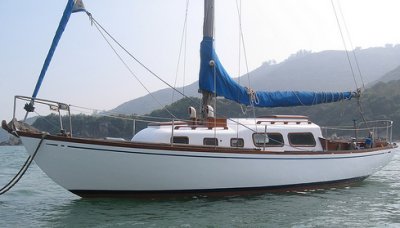
LOA: 28’ LWL: about 22’ Beam: about 8’ Draft: 4’6” Displacement: 7,850 lbs. Ballast: 3,085 lbs.
General Comments: About 60 were built at a small yard in Hong Kong. Pluses: Nice lines and good-handling with several having made ocean crossings including by myself on a delivery voyage from the Caribbean to Brazil. Minuses: Variable construction quality with tanks and bulkheads known to come loose over the years.
More info:
https://en.wikipedia.org/wiki/Taipan_28
Westsail 28
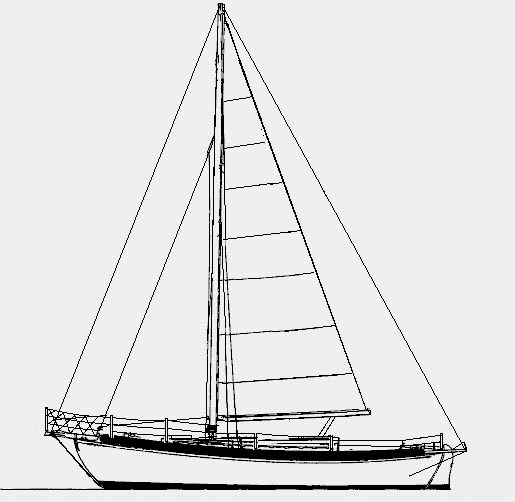
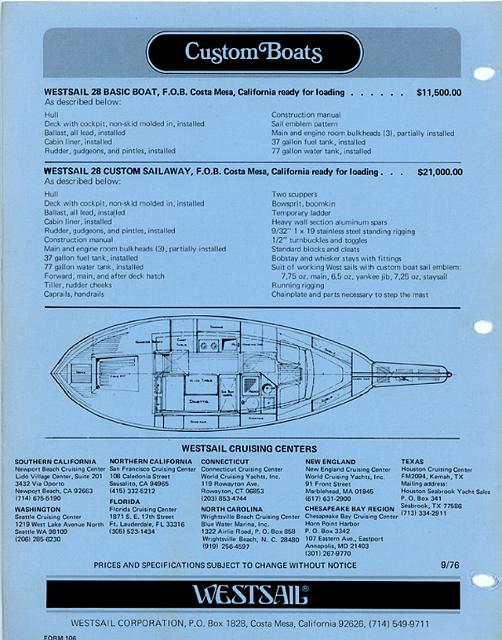
LOD: 28’ LWL: 25’ Beam: 9’7” Draft: 4’4” Displacement: 13,500 lbs. Ballast: 4,200 lbs.
General Comments: Some 60 of these smaller sister to the popular, but heavy Westsail 32 were built. Pluses: Beautiful lines and excellent heavy weather boat. Minuses: Heavy and slow in light air. A “K” in the first four digits of the hull number means it was a owner completed kit boat which will have varying construction quality. An “F” means factory finished.
More info:
http://www.westsail.org/
Alberg 29

LOD: 29’3″ LWL: 22’3″ Beam: 9’2″ Draft: 4’7″ Displacement: 9,000 lbs. Ballast: 4,000 lbs. Sail area: 416 sq. ft.
General Comments: One of Alberg’s last designs built in the 1980s as a modernized version of the Alberg 30. Pluses: 6’2″ headroom. Minuses: Limited numbers were built and not many are on the market.
More info:
http://www.twentynine.ca/
Bayfield 29
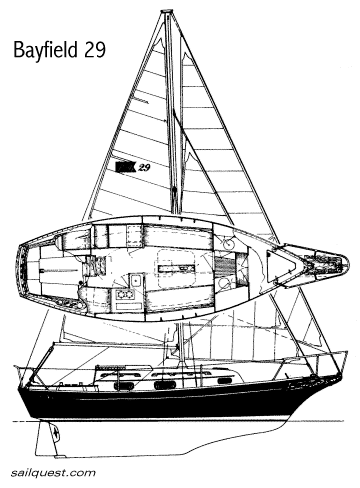
LOA: 29’ LOD: about 27’6” LWL: 21’9” Beam: 10’2” Draft: 3’6” Displacement: 7,100 lbs. Ballast: 3,000 lbs.
General Comments: Built in Ontario. Available sloop or cutter with built-in bowsprit. Pluses: The long, full keel provides shallow draft for this size boat. There is a spacious head instead of a cramped V-berth. Minuses: High-sided. Although apparently tiller steering was standard from the factory, most boats on the market today have wheel steering.
More info:
http://sailquest.com/market/models/bayf29.htm
Bristol 29
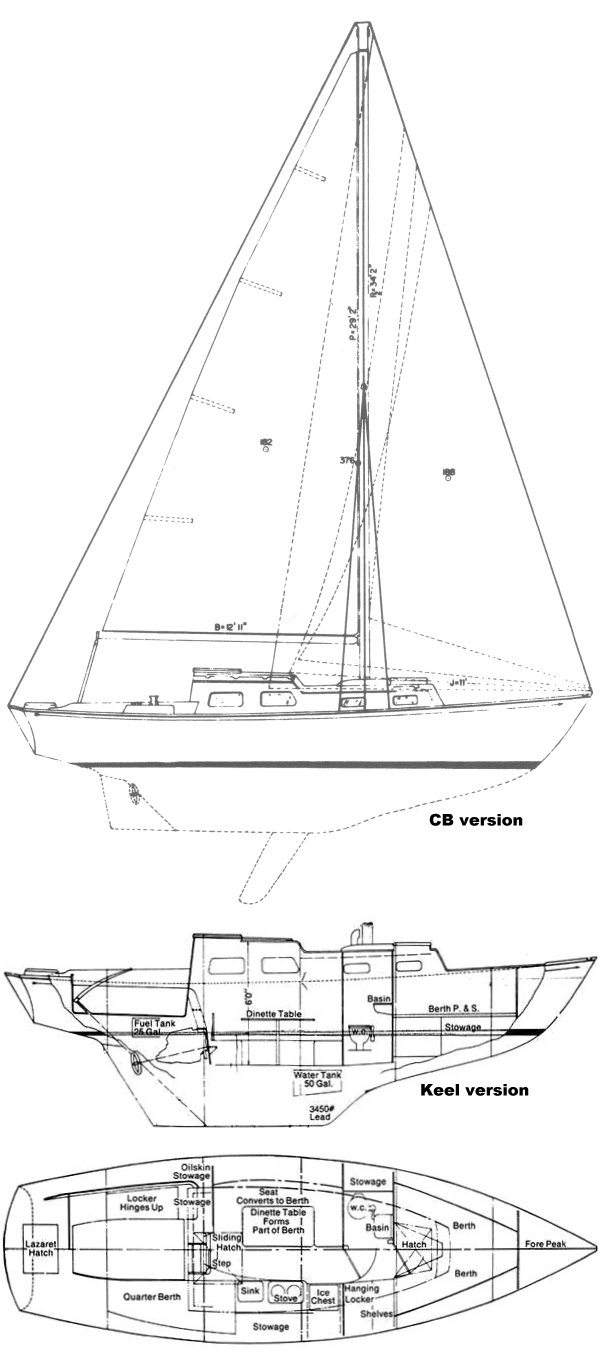
LOD: 29’2” LWL: 22’8” Beam: 9’2” Draft: 4’6” (fixed keel) Displacement: 8,400 lbs. Ballast: 3,350 lbs. internal lead. Sail area: 402 sq. ft.
General Comments: Designed by Halsey C. Herreshoff. 169 built by Bristol Yachts, Rhode Island from 1966-71. Fixed keel and centerboard versions available. Pluses: Teak toe rails. Above average construction features.
More info:
https://sites.google.com/site/bristolowners/bristol-models/bristol-29-30
Columbia 29

LOD: 28’6″ LWL: 22’6″ Beam: 8′ Draft: 4′ Displacement: 7,400 lbs. early models and 8,400 late and MKII models. Ballast: 3,120 lbs. early and 4,100 lbs. late and MKII. Sail area: 382 sq. ft.
General Comments: Sparkman & Stephens design built by Columbia Yachts. Apparently some 300 MKI and MKII versions were built between 1962-67 but I noticed only two were on the market when I did a google search in January 2009. Also some raised deck models were built as the Defender 29. Main design of hull and deck and sail plan remained the same for MKI and II with some minor cosmetic changes. Outboard well and inboard engine options. Pluses: 6′ headroom. Outboard well versions available. Minuses: Few on the market to choose from. The raised deck of the Defender model means more interior volume at the expense of high freeboard.
More info:
http://www.columbia-yachts.com/c-29.html
Elizabethan 29

LOA: 29′ LWL: 20′ Beam: 7’6″‘ Draft: 4’2″” Displacement: 7,280 lbs. Ballast: About 3,300 lbs. iron. Sail area: 308 sq. ft sloop 100% foretriangle. General Comments: CR Holman design built in UK during 1960’s. Pluses: 5’10” headroom. Her long overhangs reduce wetted surface drag in light airs and she picks up waterline length quickly when heeled. Minuses: The E29 I was aboard struck me how narrow the beam was and cramped feeling below compared to other similar length boats – even the Pearson Ariel 26 seems roomier inside. Access to the inboard engine is tight.
More info:
https://www.eoa2.org/elizabethan29
Islander 29
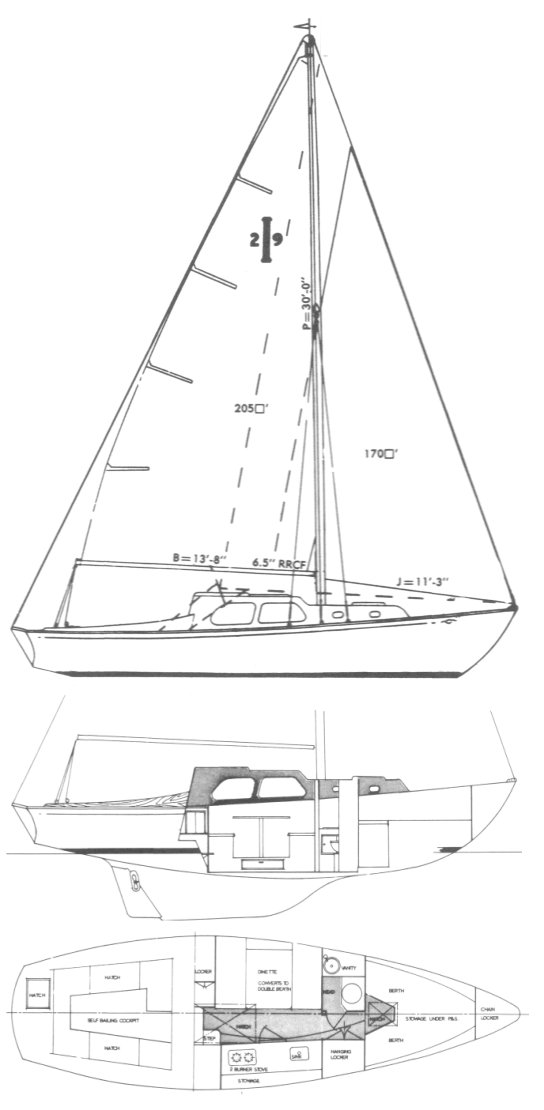
LOA: 29′ LWL: about 23′ Beam: 8’11″‘ Draft: 3’8″ Displacement: 7,800 – 8,100 lbs. ? Ballast: 2,500 lbs.? lead. Total sail area: 392 sq. ft. General Comments: Built by Wayfarer Yachts of Costa Mesa, CA. beginning in 1969. Also called the Wayfarer 29. Minuses: Low companionway entrance looks vulnerable to flooding, but can be modified. Atomic 4 gas inboard was standard. Not many produced.
More info:
http://www.sailboatdata.com/viewrecord.asp?class_ID=691
Tripp 29
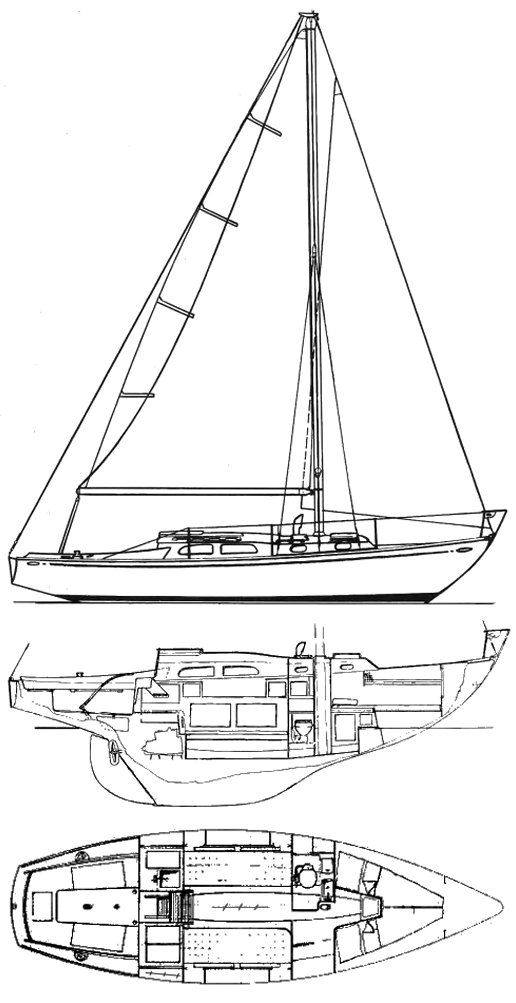
LOA: 28’11” LWL: 20’7″ Beam: 8’11″‘ Draft: 4’7″ Displacement: about 7,800 Ballast: 3,003 lbs. external lead. Total sail area: 363 sq. ft 100% foretriangle masthead sloop.
General Comments: Designed by Bill Tripp. About 50 were built in Holland, mostly by Devries Lentsch Amsterdam Boatyard between 1963-?. 6’1″ headroom in salon and less forward. 6’4″ long settee/bunks. Keel-stepped aluminum mast with spruce spreaders and roller reefing spruce boom. Atomic 4 gas engine. Pluses: A good size overhanging transom permits a custom tilt-up outboard well installation in lazarette but some modification of cockpit is required. This boat has a narrow coachroof with wide side decks. Partial fiberglass liner inside with chainplates bolted through solid fiberglass rather than wood knees or plywood bulkheads. Good quality build construction. Fiberglass rudder with solid bronze shaft and shoe. Unusually wide (33″) companionway entrance makes for good ventilation and the high bridgedeck makes it very seaworthy. Minuses: Balsa cored deck was properly sealed at factory for most deck fittings but some areas may be susceptible to core rot since these boats are over 50 years old now.
More info:
Tripp 29
Westerly Konsort 29
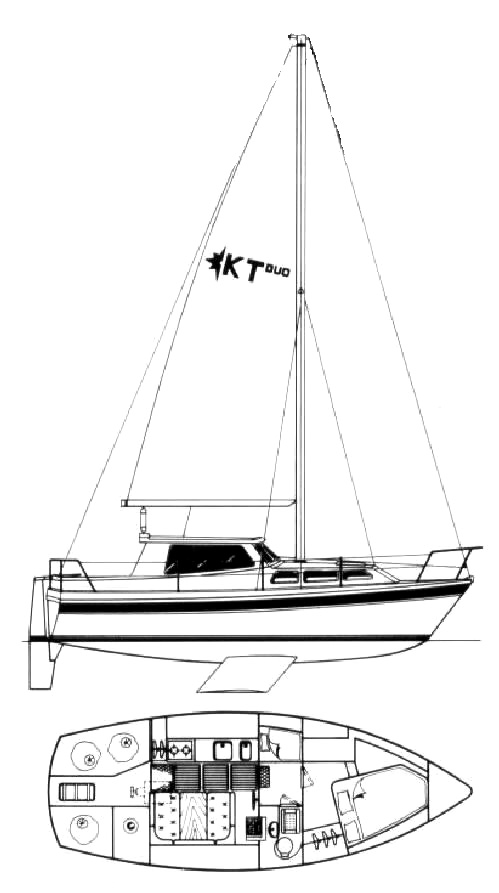
LOD: 28’10” LWL: 25’7” Beam: 10’9” Draft: 3’3” Displacement: 9,211 lbs. Ballast: 3,200 lbs. Total sail area: 392 sq. ft.
General Comments: Like her smaller sister the 26’ Centaur, this Laurent Giles designed British boat is listed here among modified full-keelers mainly because its shallow draft and ability to stand upright on her twin keels may be priorities for some sailors. Minuses: Relatively poor light air and windward performance of twin keels. Deep draft fin keel and pilothouse versions not applicable to this list. More info:
https://sailboatdata.com/sailboat/konsort-29-westerly
Alberg 30
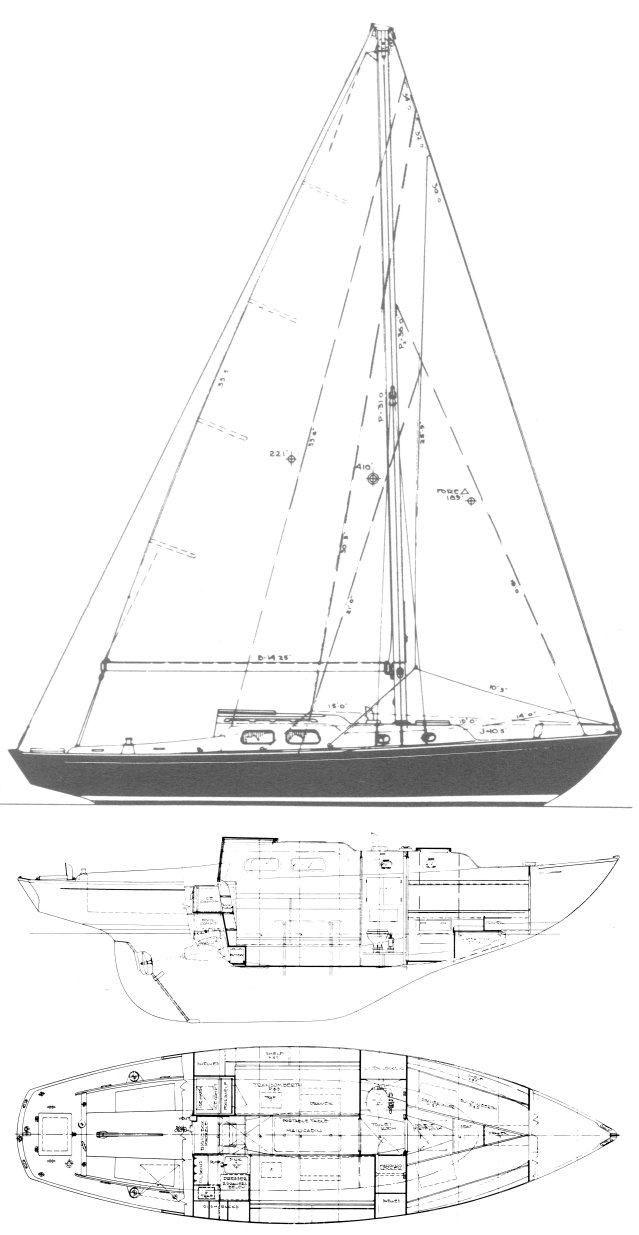
LOA: 30’3” LOD: 30’3” LWL: Beam: 8’9” Draft: 4’3” Displacement: 9,000 lbs. Ballast: 3,300 lbs. (encapsulated cast iron) Sail area: 410 sq. ft.
General Comments: Alberg design. Some 750 built by Whitby Boat Works in Ontario from 1962-84. Most of the keel hung rudders are fiberglass composite. Around 1970 there were several changes made including going to a fiberglass interior hull liner, adding a molded fiberglass toe rail with teak cap instead of an all teak toe rail, and improved mast step reinforcement. Before around 1970 the deck and cabin house core may have been masonite, though I know of at least one 1968 model with balsa core. Later models used balsa. Masthead rig. Price range: from average $12K up to $25K. Pluses: Proven circumnavigator. Headroom ranges from a minimum of 6′ for hull liner models to possibly 6’1″ on early models. This is one of my favorite designs. The proportions seem just right. And the ample lazarette locker makes an easy conversion to an outboard well. Minuses: Atomic 4 gas inboard, but many have converted to diesel. Weak forward lower shroud chain plate knees and undersized chain plates. Deck mast step plate has screws that leak into core. Before 1970 the weak laminated mast support deck beams usually need extra support added. Later they added an aluminum support beam within the fiberglass liner. Old teak toe rails prone to leaking and may need replacement. I are placed one with aluminum toe rail. The fiberglass water tank under v-berth is only about 15 gals but integral tanks can be added there or in bilge.
More info:
http://www.alberg30.org/
There are several A30 refit video tours on my YT channel, such as:
https://www.youtube.com/watch?v=zXdS0ufiu1I
https://www.youtube.com/watch?v=-aIKJlfC7GA
https://www.youtube.com/watch?v=t7FLbexHsq4&t=4s
https://www.youtube.com/watch?v=mDRrJ_udl7Y
Allied Seawind Ketch 30

LOA: 30’6” LWL: 24’ Beam: 9’3” Draft: 4’3” Displacement: 12,080 lbs. Ballast: 4,200 lbs. lead. Sail area: 500 sq. ft.
General Comments: Thomas Gilmer design built by Allied Boat Company of New York. 161 boats were launched between 1962 to 73 of which about 10 were sloop or cutter rigged. First fiberglass boat to circumnavigate. Don’t confuse with the Seawind II which is a foot longer and has wheel steering. Minuses: A bit slow to windward in light airs and the hull/deck joint is reported prone to leaking.
More info:
https://sailboatdata.com/sailboat/seawind-allied
Bristol 30

LOA: 30’6″ LWL: 22’8” Beam: 9’2” Draft: 4’6” std. keel. (centerboard version 3’4”) Displacement: 8,400 lbs. Ballast: 3,450 lbs. (internal lead) Sail area: 402 sq. ft.
General Comments: Halsey C. Herreshoff sloop design, 174 built from 1968-1978, based on the Bristol 29 hull.
More info:
https://sailboat.guide/bristol/30
Cal 30
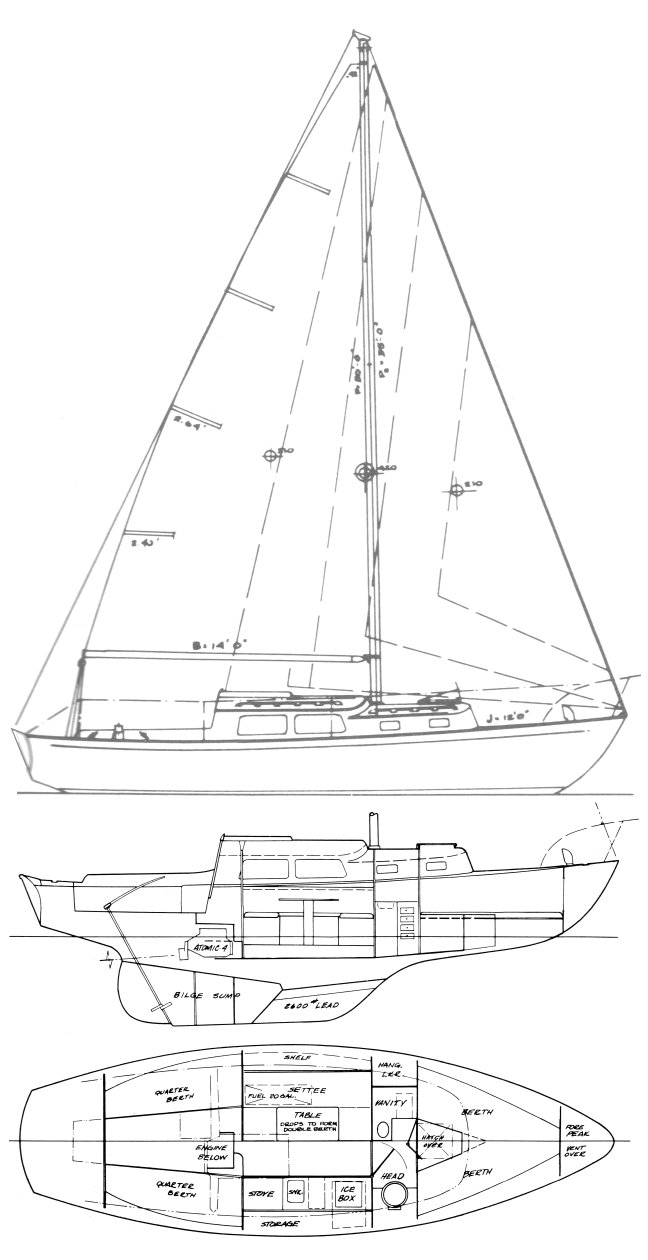
LOA: 30′ LWL: 24’6″ Beam: 10′ Draft: 4’6″ Displacement: 9,600 lbs. Ballast: 3,500 lbs. lead.
General Comments: C.W. Lapworth design built by Jensen Marine in the 1960’s. Not to be confused with the fin keel spade rudder Cal 2-30. Minuses: Atomic 4 gas inboard was standard.
More info:
http://www.sailboatdata.com/viewrecord.asp?class_ID=864
Cape Dory 30
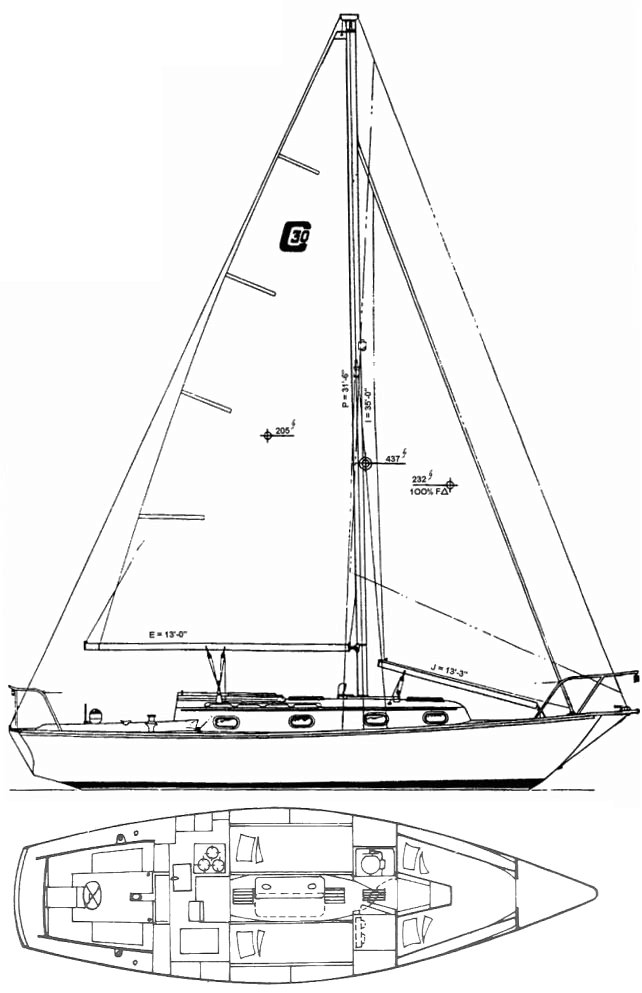
LOA: 30 2″ LWL: 22’10” Beam: 9′ Draft: 4’2″ Displacement: 10,000 lbs. Ballast: 4,000 lbs. Sail area: 437 sq. ft. cutter. General Comments: Alberg design. 363 built between 1976-86. Tiller or wheel steering available.
More info:
http://www.capedory.org/specs/cd30.htm
Cheoy Lee Bermuda 30

LOA: 29’7″ LWL: 24′ Beam: 8’9″ Draft: 3’8″ Displacement: 10,100 lbs. Ballast: Sail Area: 343 sq. ft.
General Comments: Available as ketch or sloop. Built in Hong Kong from 1962-67 in wood and fiberglass. Minuses: Lots of exterior wood to maintain even on the fiberglass version.
More info:
http://www.cheoyleeassociation.com/bermudas.htm
Cheoy Lee Luders 30

LOA: 29’10” LWL: 22′ Beam: 9’1″ Draft: 4’9″ Displacement: 9,900 lbs. Ballast: 3,750 lbs. Sail area: 425 sq. ft.
General Comments: Bill Luders design built in Hong Kong. Apparently most came with wheel steering though some have a tiller. Minuses: The trademark Cheoy Lee exterior teak needs constant maintenance or even major repairs by now if the previous owner has neglected her.
More info:
http://www.cheoyleeassociation.com/ludders30.htm
Morris Annie 30
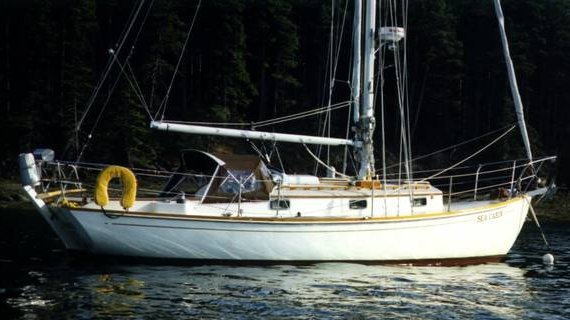
LOA: 29’8″ LWL: 24’9″ Beam: 9’8″ Draft: 4’6″ Displacement: 10-11,000 lbs. Ballast: 4,400 lbs lead. Total sail area: 446 sq. ft. (100% foretriangle)
General Comments: Designed by Chuck Paine. Built by Morris Yachts from 1980 on. Sometimes referred to as the Morris 29. A similar design but with canoe transom is the Morris Leigh 30, which is a scaled up version of the Frances 26. Pluses: High quality construction and lovely design. Minuses: Expensive and hard to find since not many were produced.
More info:
http://www.chuckpaine.com/pdf/30ANNIE230.pdf
Rawson 30

LOA: 32’6″ LOD: 30’6″ LWL: 22′ Beam: 9′ Draft: 5′ Displacement: 12,500 lbs. Ballast: 5,000 lbs. Sail area: 565 sq.ft.
General Comments: William Garden design. Some 250 sloops, as well as some pilothouse versions and ketch rigs were built in Redmond, WA from about 1960-84. Pluses: 6’3″ – headroom if you happen to need it. Minuses: Heavy and therefore somewhat slow in light air, though a bowsprit was added to later models to increase sail area and reduce weather helm. Offered also as owner finished kit boat with resulting variable finish quality.
More info:
https://sailboat.guide/rawson/30
Cape George 31
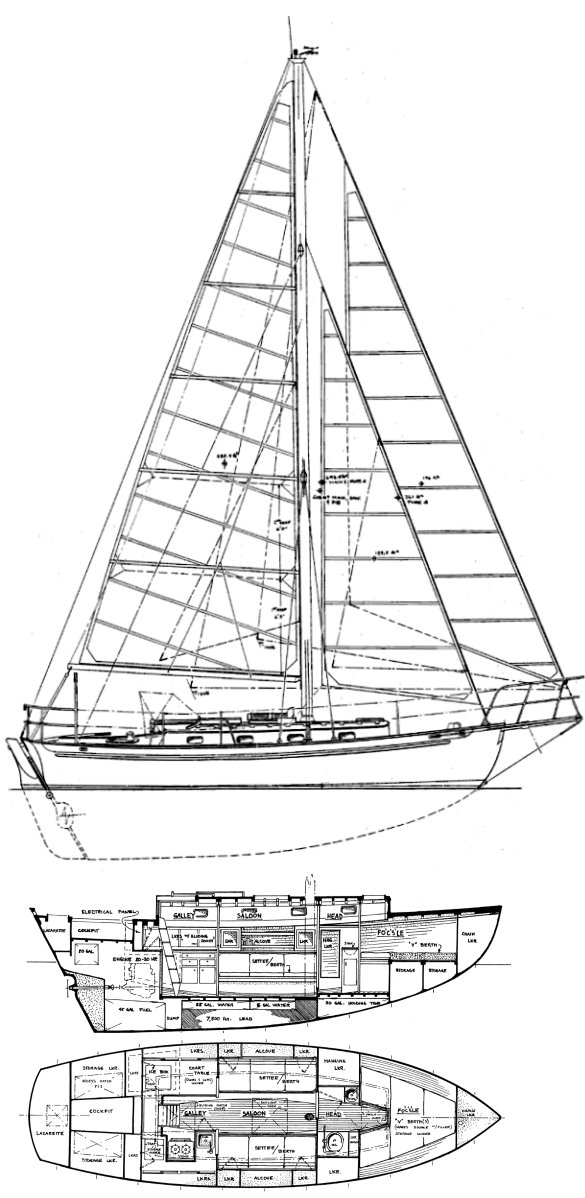
LOA: 36′ LOD: 31′ LWL: 27’6″ Beam: 9’6″ Draft: 4’6″ Displacement: 15,835 lbs. Ballast: 7,200 lbs. internal lead. General Comments: Cecil Lange design cutter rig with bowsprit built in Port Townsend. Pluses: The factory finished boats are exquisite in design and quality. Minuses: Some are owner finished kit boats. Rare, expensive and heavy.
More info:
http://capegeorgecutters.com/_boat-designs/cape-george-cutter-21/
Cheoy Lee Offshore 31
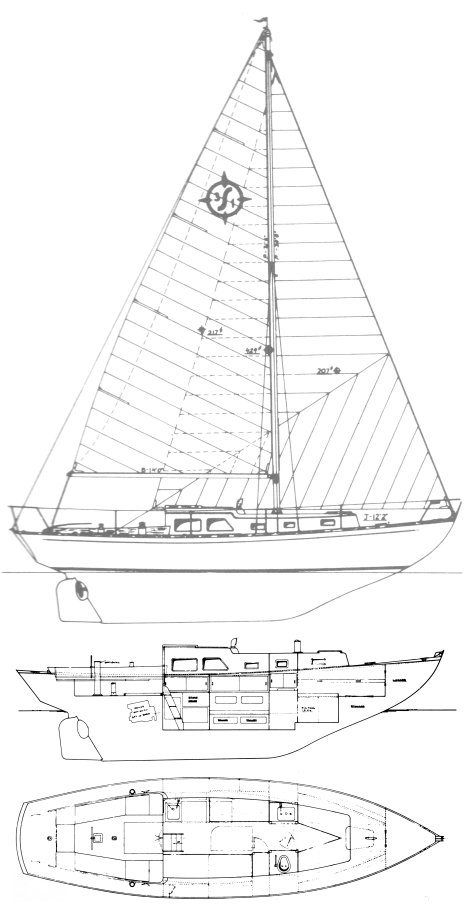
LOA: 30’9″ LWL: 23’4″ Beam: 8’10” Draft: 3’10” Displacement: 10,750 lbs. Ballast: 4,000 lbs. Sail area: 424 sq. ft.
General Comments: Built in Hong Kong by Cheoy Lee in sloop or ketch rig. in the 1960’s. Minuses: Teak decks and lots of exterior wood trim to maintain. Only some of the boats have tiller steering.
More info:
http://www.cheoyleeassociation.com/offshore31.htm
Golden Hind 31
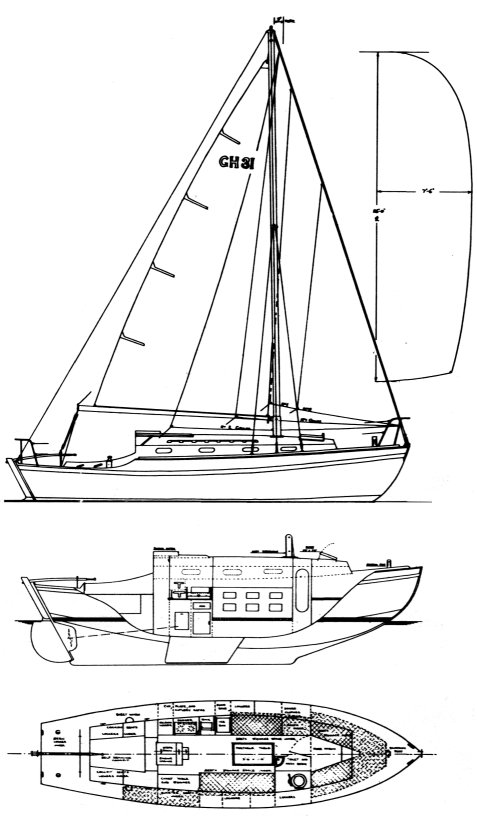
LOA: 34′ LOD: 31’6” LWL: 26’9” Beam: 9′ Draft: 3’8″ Displacement: 13,500 lbs. Ballast:5,100 lbs. Sail area: 426 sq. ft.
General Comments: Maurice Griffiths design sloop or cutter, mostly built in the UK, first in hard chine plywood and later in fiberglass. Full keel with bilge plates. Pluses: Good boat if you need shoal draft and ability to stand the boat upright on it’s bilge keel plates. 6’2″ headroom. Minuses: If you don’t particularly need the shallow draft, the bilge plates along with full keel add drag reducing sailing efficiency.
More info:
http://www.eventides.org.uk/goldpic.htm
Hallberg-Rassy Monsun 31
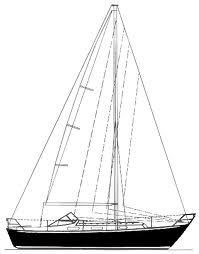
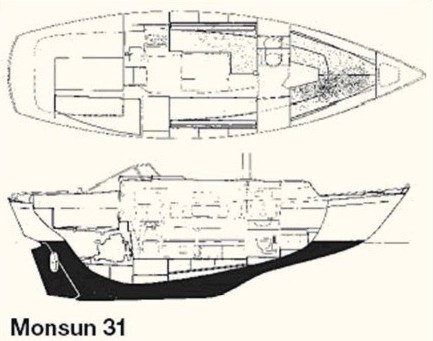
LOA: 30’9” LWL: 24’8” Beam: 9’5 Draft: 4’7″ Displacement: 9,250 lbs. Ballast: 4,200 lbs. Sail area: 430 sq. ft.
General Comments: Over 900 hulls built by Hallberg-Rassy in Sweden between 1974-82. Pluses: Good build quality with several having circumnavigated.
More info:
https://www.hallberg-rassy.com/yachts/previous-models/hallberg-rassy-monsun-31/
Nicholson 31

LOA: 31’7” LWL: 24’2” Beam: 10’3” Draft: 5’ Displacement: 14,750 lbs. Ballast: 5,300 lbs. Sail area: 500 sq. ft.
General Comments: Built in the UK by Caper & Nicholson as an updated version of the Nicholson 32 which would be on this list as well if not for it’s excessive 5’6″ draft. Pluses: Transom-hung rudder and overall solid good quality.
More info:
https://nicholson31.com/about/aboutnicholson31/
Pacific Seacraft 31
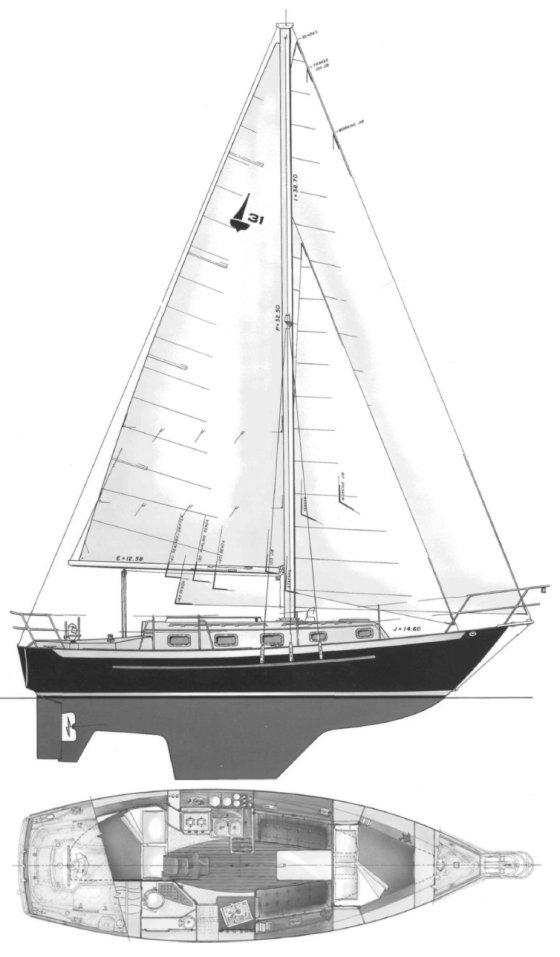
LOA: 31’10” LOD: 30’6” LWL: 24’2” Beam: 9’10” Draft: 4’/4’11” shoal option/standard full keel. Displacement: 11,000 lb. Ballast: 4,400 lb. external lead. Sail area: 485 sq. ft. sloop, 600 cuter.
General Comments: Crealock design. Early models available with optional tiller, although wheel steering is more common. Some boats have an open interior plan instead of the usual closed off V-berth. Minuses: Expensive. Even though it has a skeg rudder it is well protected and supported by the substantial skeg.
More info:
http://features.boats.com/boat-content/2000/08/cruising-expert/
Pacific Seacraft Mariah 31


LOA: 36’ LOD: 31’ LWL: 25’ Beam: 10’9” Draft: 4’6” Displacement: 16,000 lb. Ballast: 6,000 lb. Sail area: 596 sq. ft. General Comments: Available with tiller or wheel. Mark II version has bowsprit extended by one foot and a few other variations. Pluses: High quality design and construction typical of Pacific Seacraft. Minuses: Heavy and expensive.
More info:
https://bluewaterboats.org/pacific-seacraft-mariah-31
Southern Cross 31

LOA: 34’6” LOD: 31’ LWL: 25’ Beam: 9’6” Draft: 4’6” Displacement: 13,600 lb. Ballast: 4,400 lb. internal lead.
General Comments: Thomas Gilmer designed double-ended cutter with external rudder. Airex cored hulls. Two standard interior layouts – one with standup nav station over a large locker and one with quarterberth. A larger though similar Gilmer design is the Aries 32, but only about 20 of those were built. Pluses: Eight opening ports and two hatches provide good ventilation. Minuses: Some have owner-finished interiors of mixed quality.
Details at:
http://www.southerncross-boats.org/
Pearson Vanguard 32
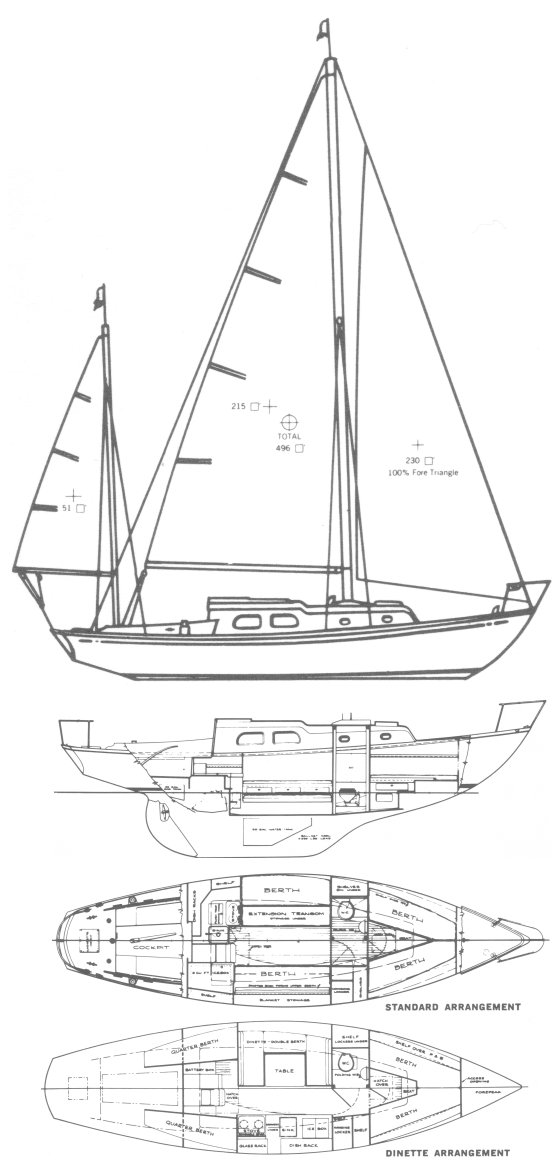
LOA: 32’6″ LWL: 22’4″ Beam: 9’3″ Draft: 4’6″ Displacement: 10,300 lbs. Ballast: 4,250 lbs. internal lead. Sail area: About 470 sq. ft.
General Comments: Phil Rhodes design. Most of the 400 some boats built between 1963-67 were rigged as masthead sloop. Relatively narrow beam with long overhangs make her less roomy than many 32-footers, but her lines are sweet and she sails well. Pluses: Not burdened with excessive freeboard, beam or displacement for a 32-footer. 6′ 4″ headroom if you need it. Minuses: Atomic 4 standard gas inboard is best replaced by diesel or, if you don’t require extended motoring range, with an electric drive as a friend of mine has done with his. A tilt-up outboard well built into the lazarette may be an option because of the ample overhanging transom.
More info:
https://bluewaterboats.org/pacific-seacraft-mariah-31
Rhodes Chesapeake 32

LOA: 31’9″ LWL: 22’1″ Beam: 8’9″ Draft: 4’9″ Displacement: ? Ballast: 3,750 lbs. external lead. Sail area: 408 sq. ft. working sail and 588 with genoa.
General Comments: Phil Rhodes design similar to his Pearson Vanguard with less beam and deeper draft and more tradition looking square cabin top. About 95 were built in Denmark between 1961-65.
More info:
https://www.cruisingworld.com/classic-plastic-chesapeake-32/
Westsail 32
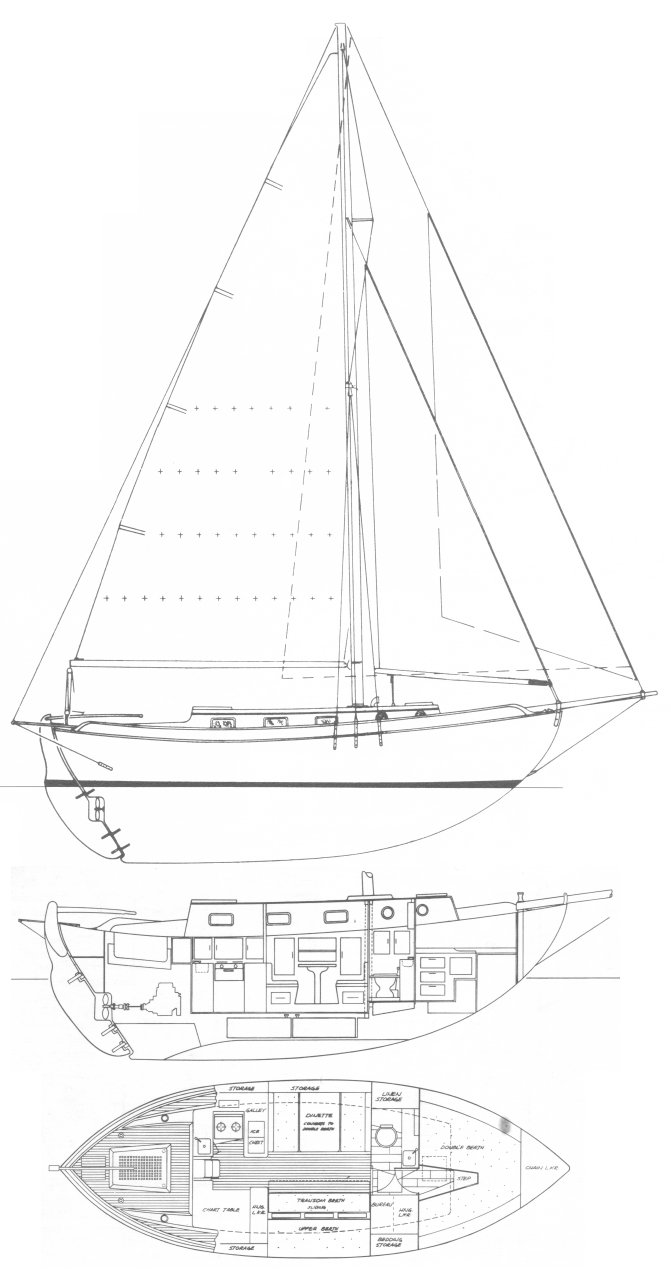
LOA: About 40′ including bowsprit and boomkin. LOD: 32’ LWL: 27’6” Beam: 11’ Draft: 5’ Displacement: 19,500 Ballast: 7,000 lbs internal (lead/iron on early boats and all lead casting on later models). Sail area: 629 sq. ft.
General Comments: William Crealock design based on a modified Kendall 32 which was descended from the double-ended Colin Archer pilot boats. About 830 W32’s were built between 1971-80 of which about half were owner finished kits. Pluses: 6’2 headroom. Massively constructed and easily able to carry over a ton of stores. Many of the deck-stepped masts have been rigged with a tabernacle allowing you to raise and lower the mast. Proven heavy weather capable circumnavigator. Check that mast support beam has proper support at base. Minuses: Heavy and slow in light airs, particularly to windward. Lack of cockpit coamings and the high bulwarks amidships mean cockpit can get very wet in heavy weather when water comes over the lee bow and is channeled to the cockpit. Adding amidships scuppers and backrests to the cockpit reduces this problem. Lots of aging exterior teak to maintain.
More info:
http://en.wikipedia.org/wiki/Kendall_32
http://www.westsail.org/
